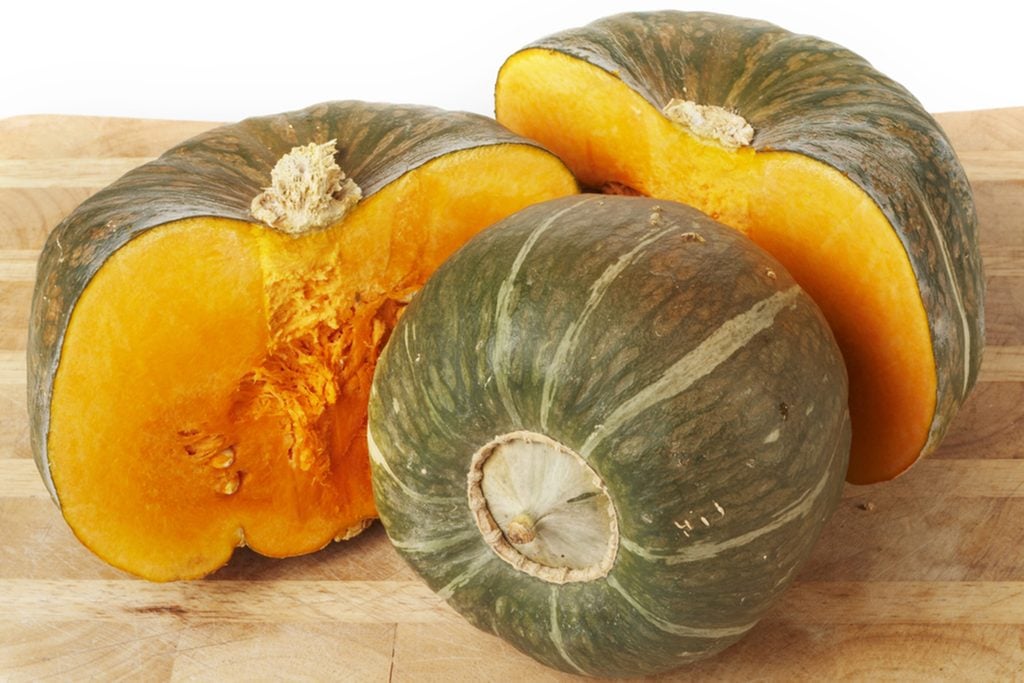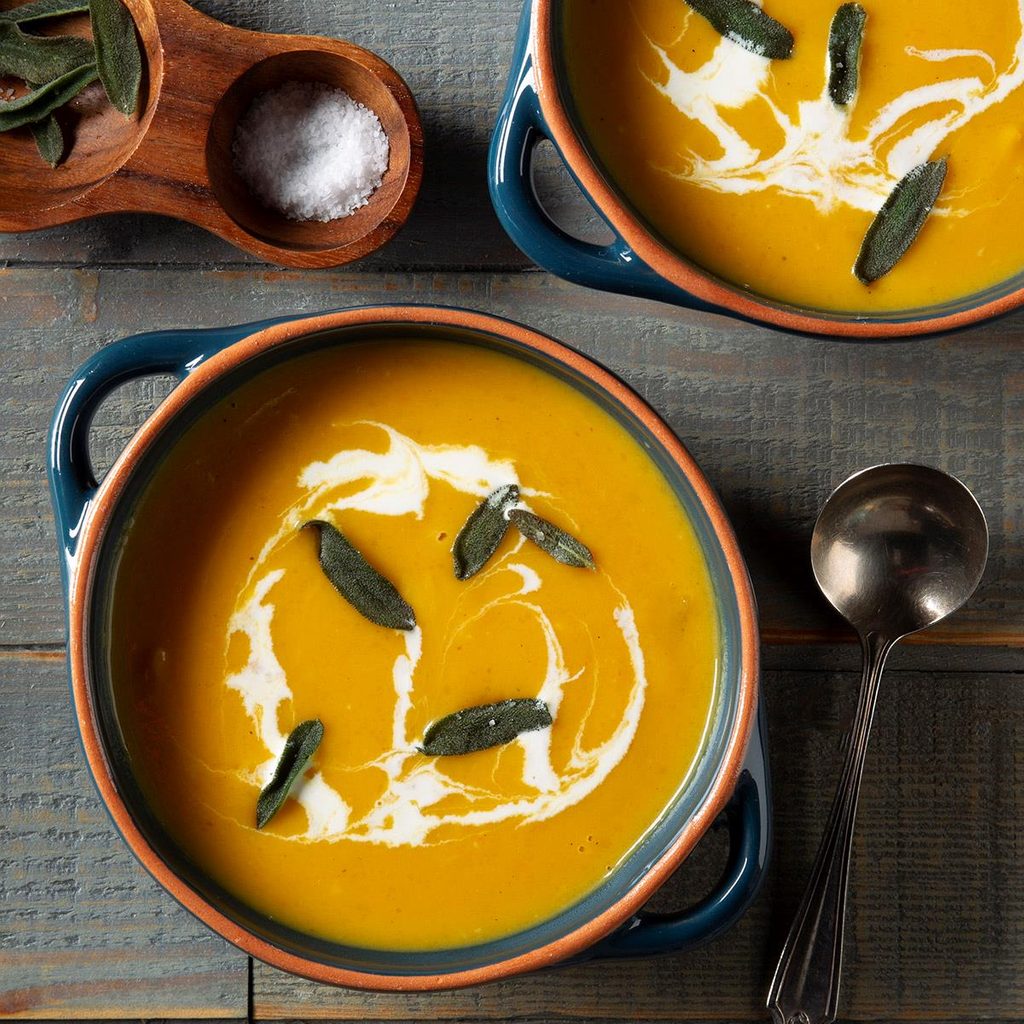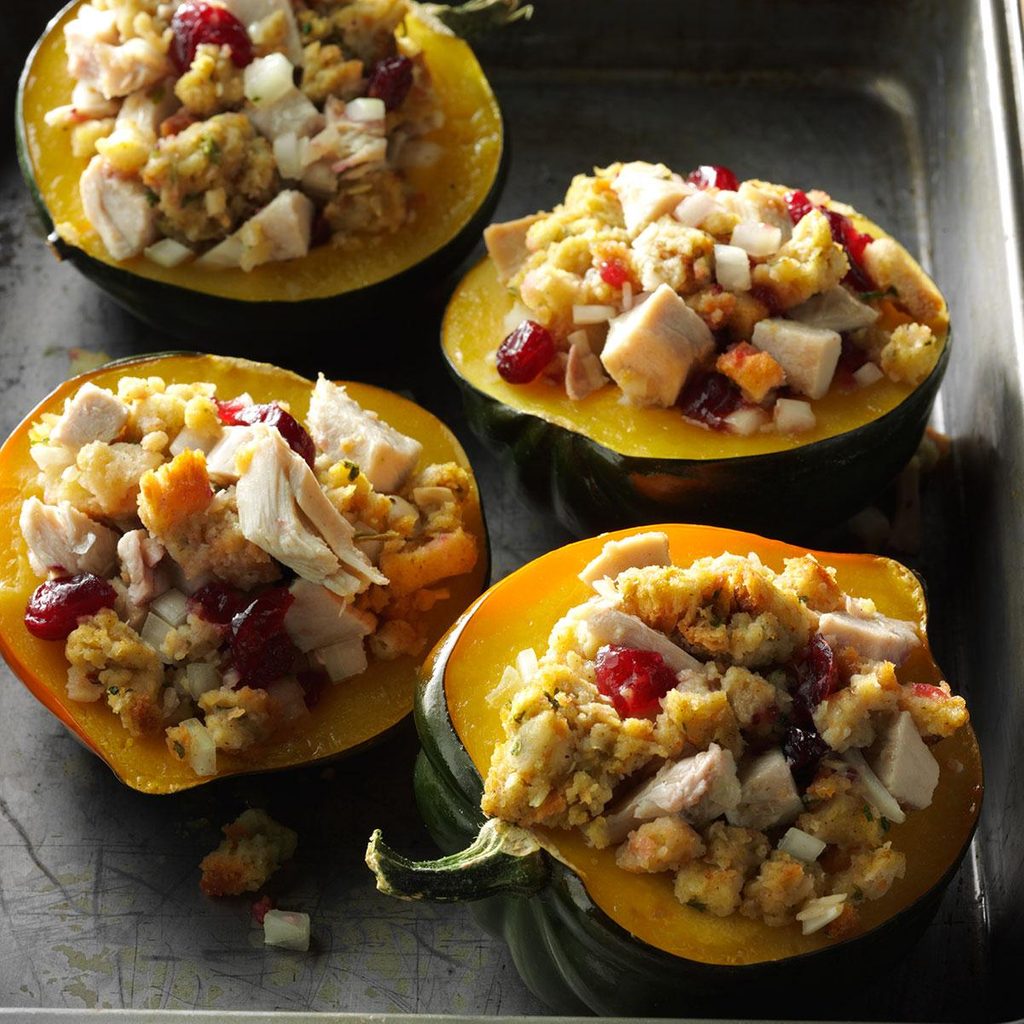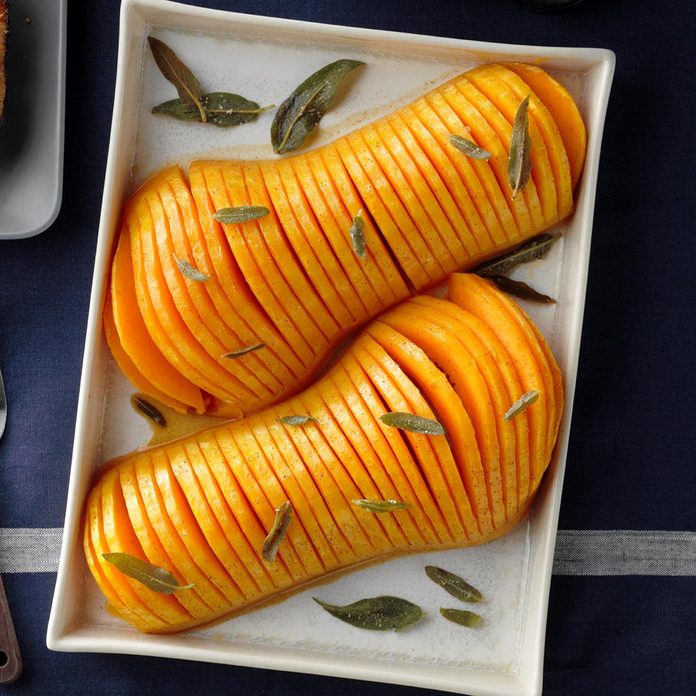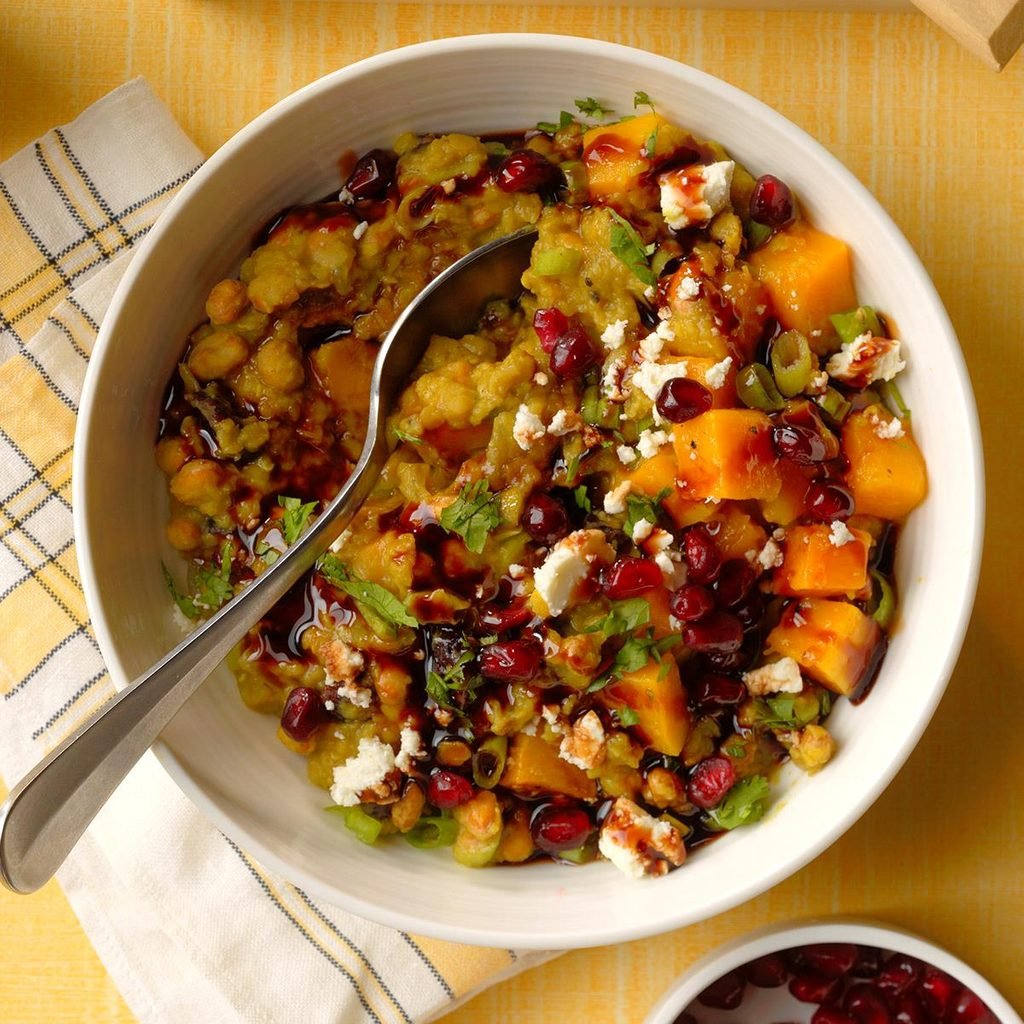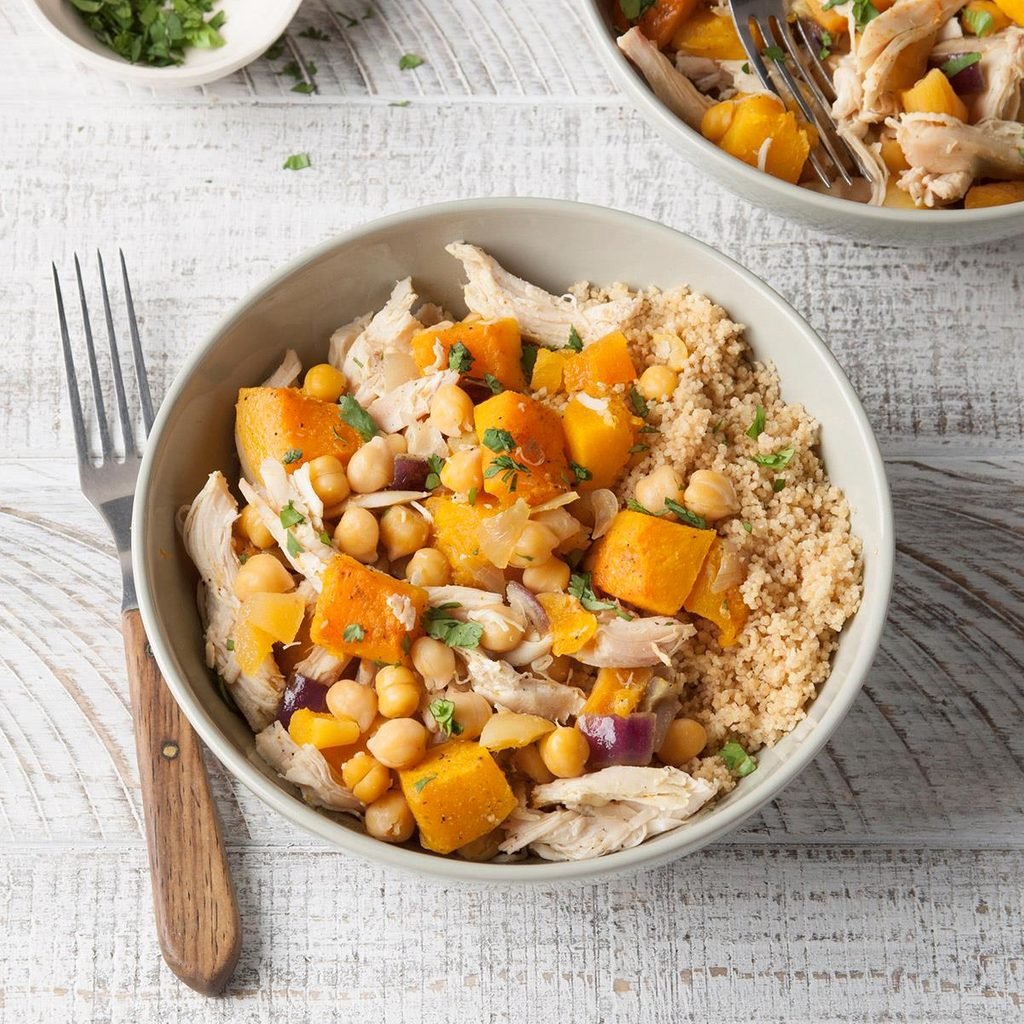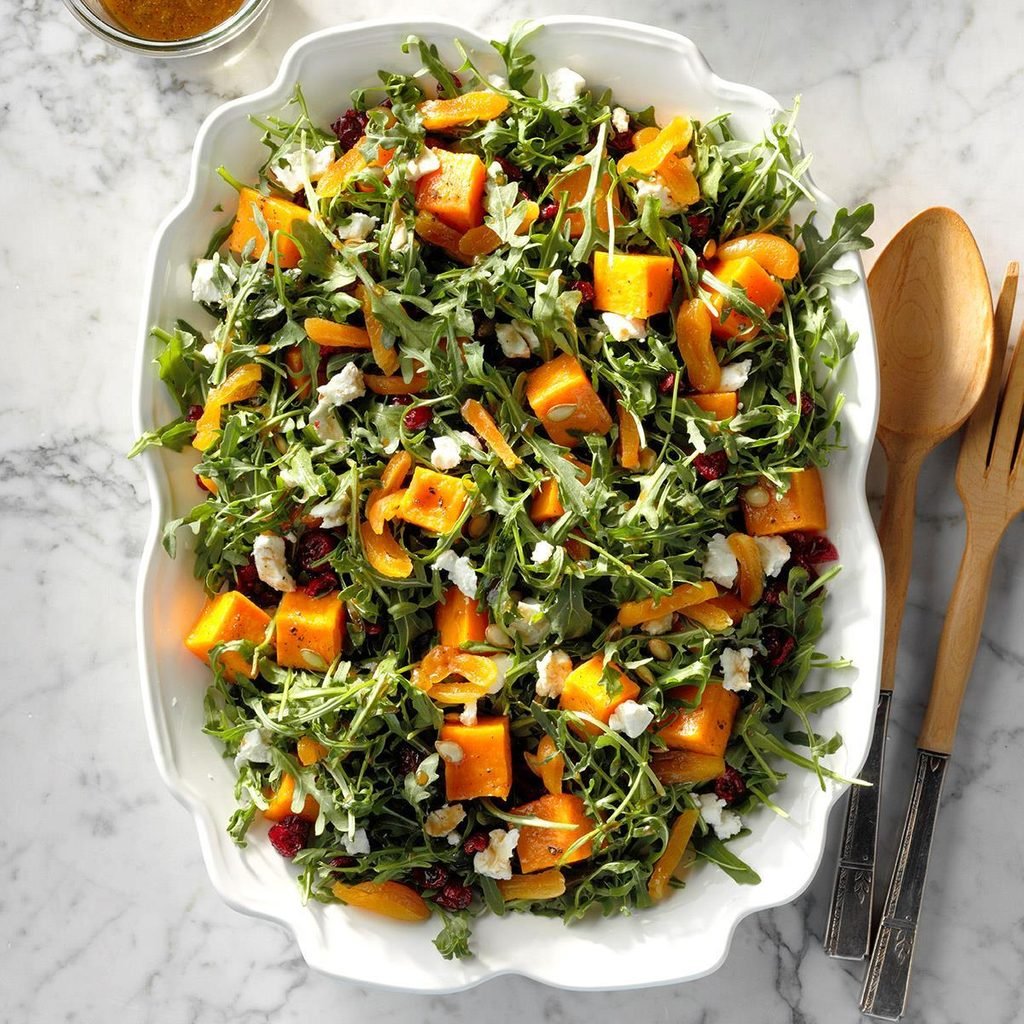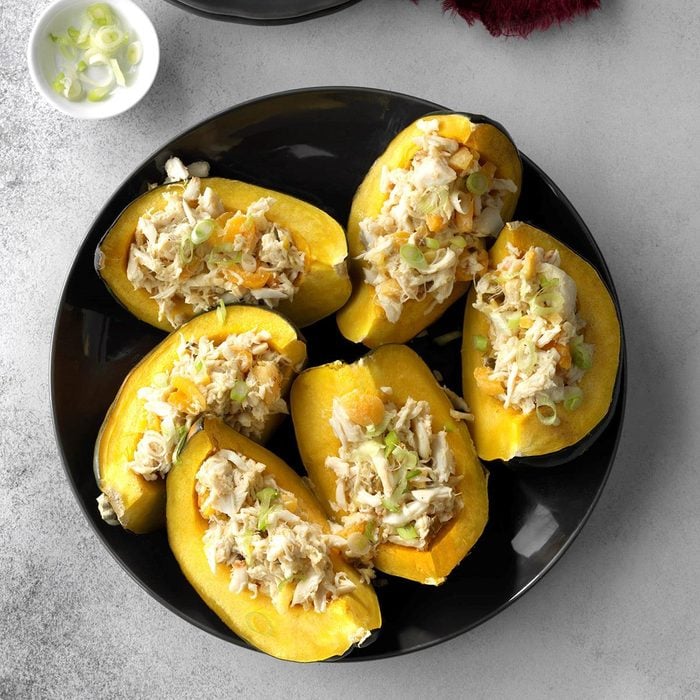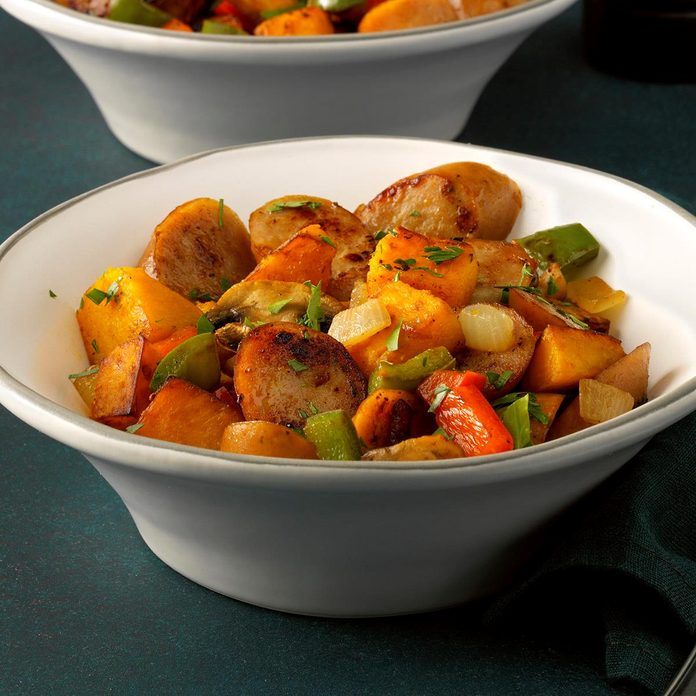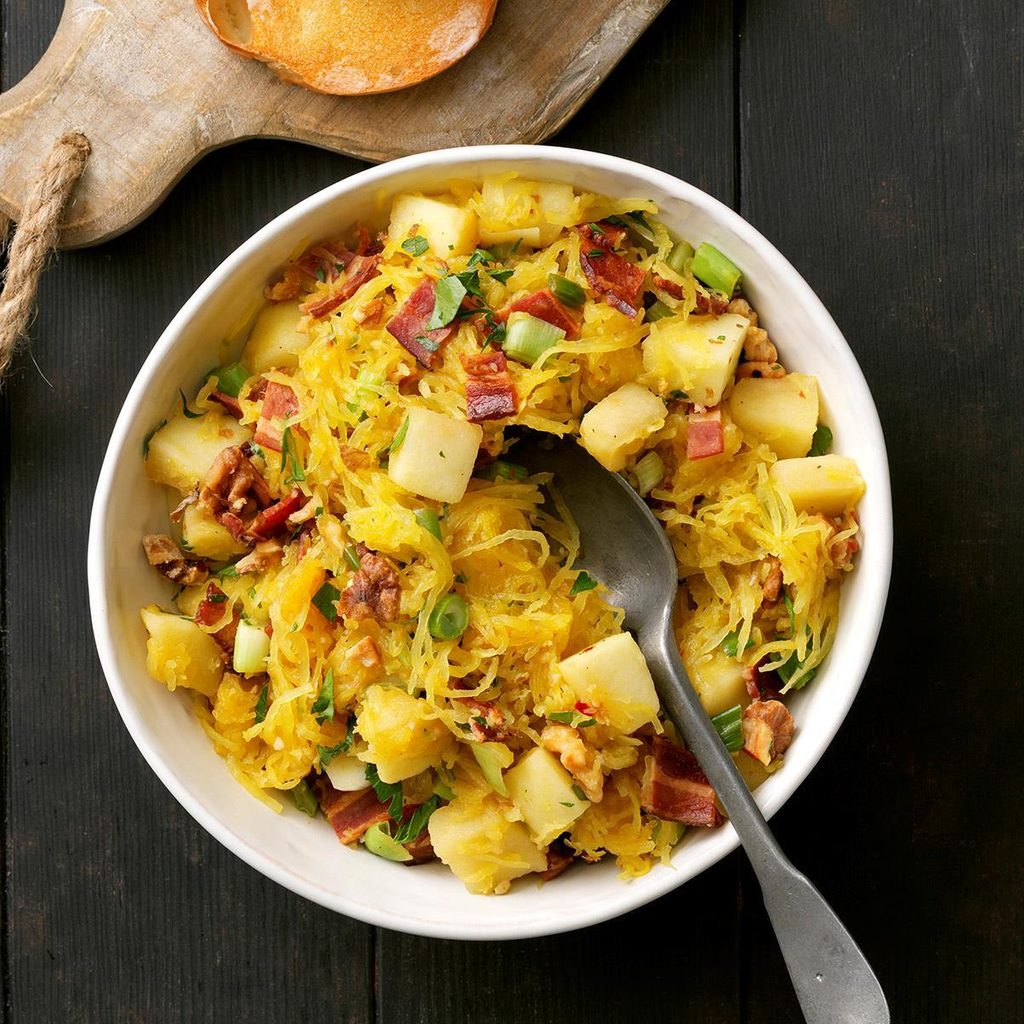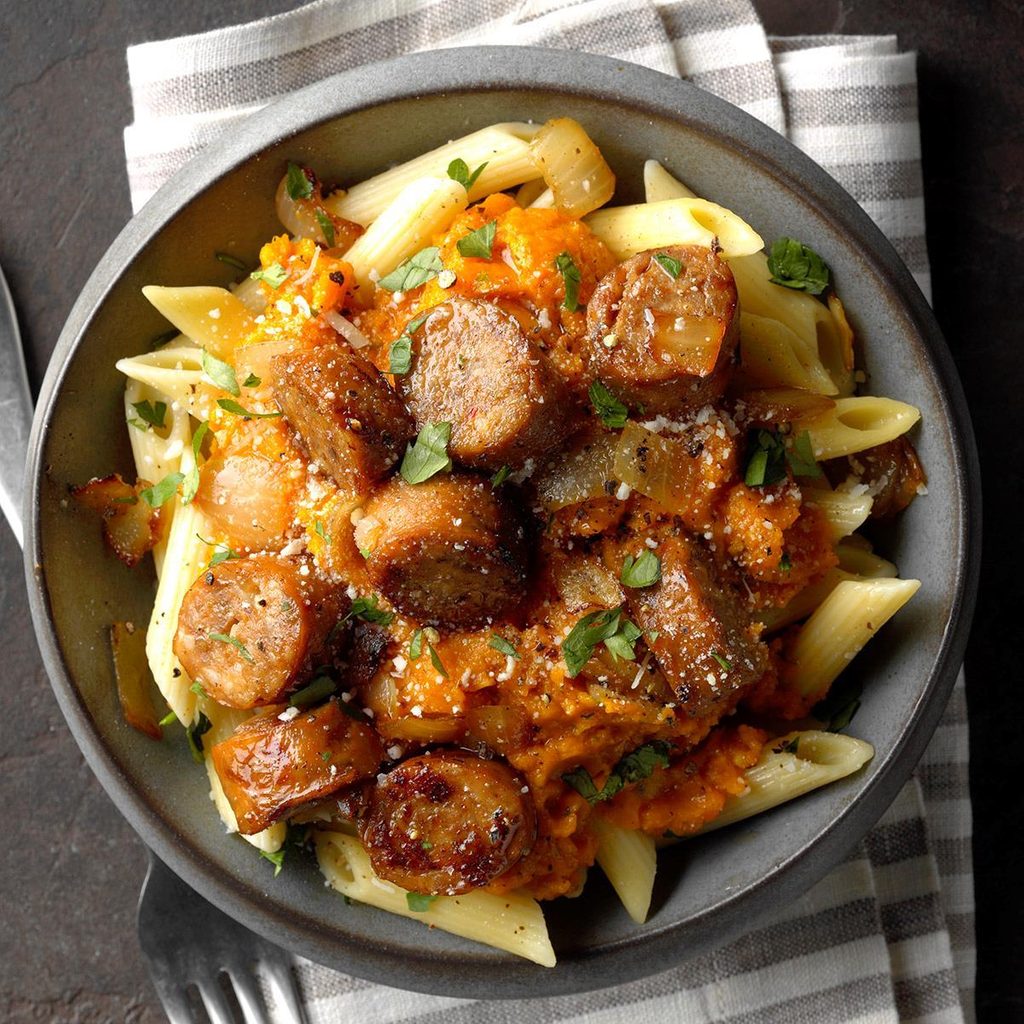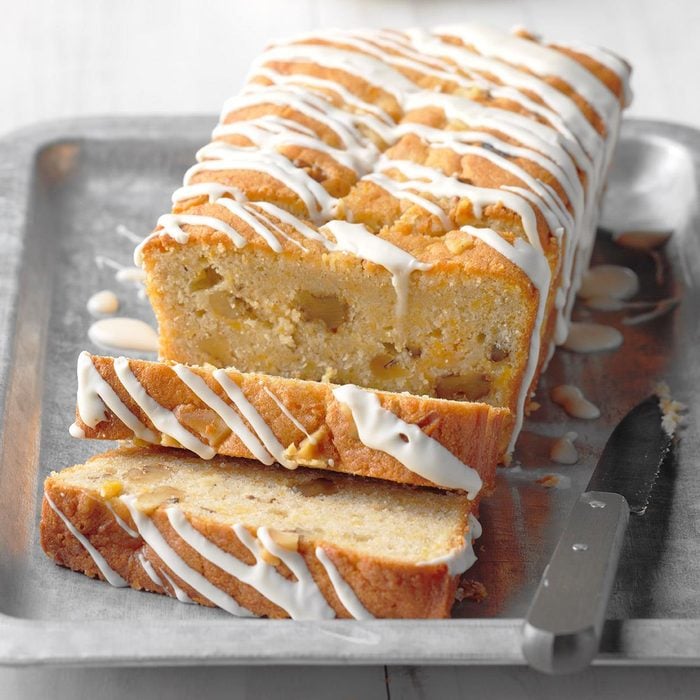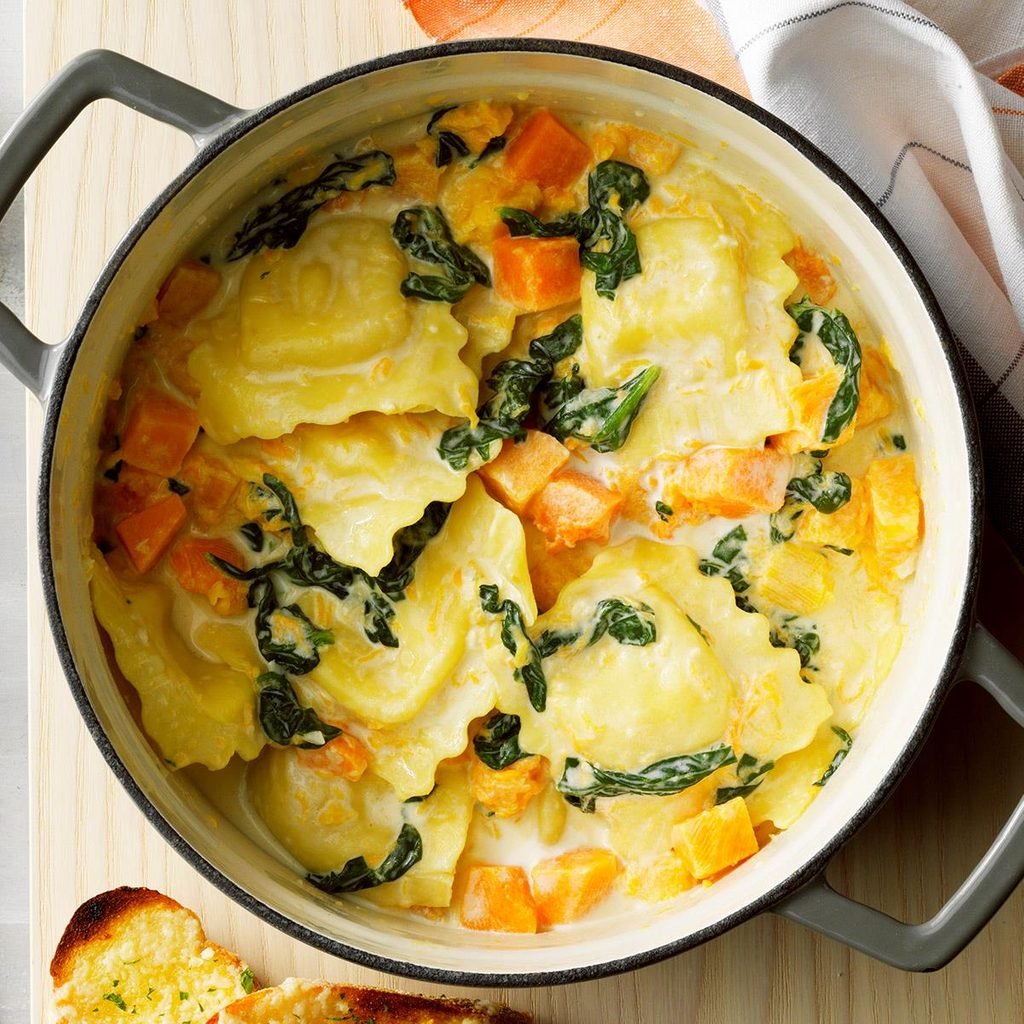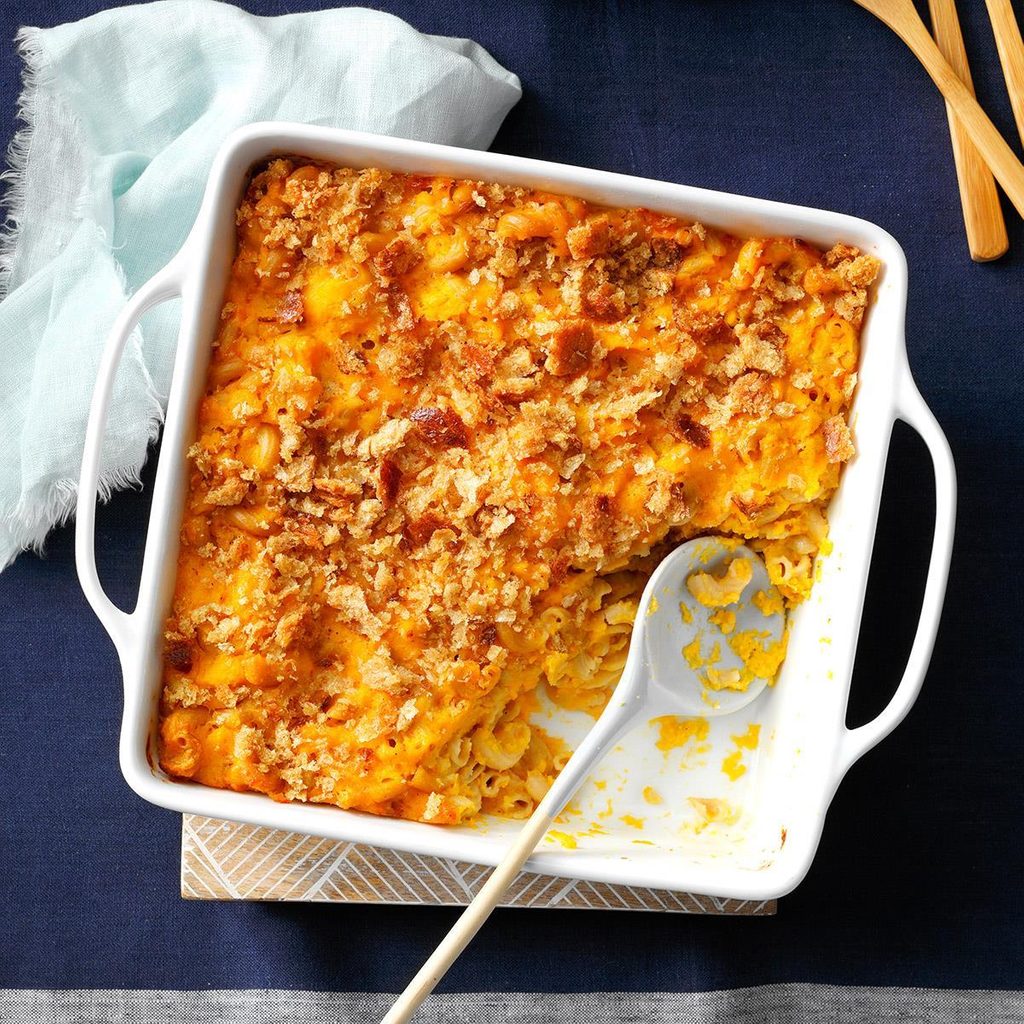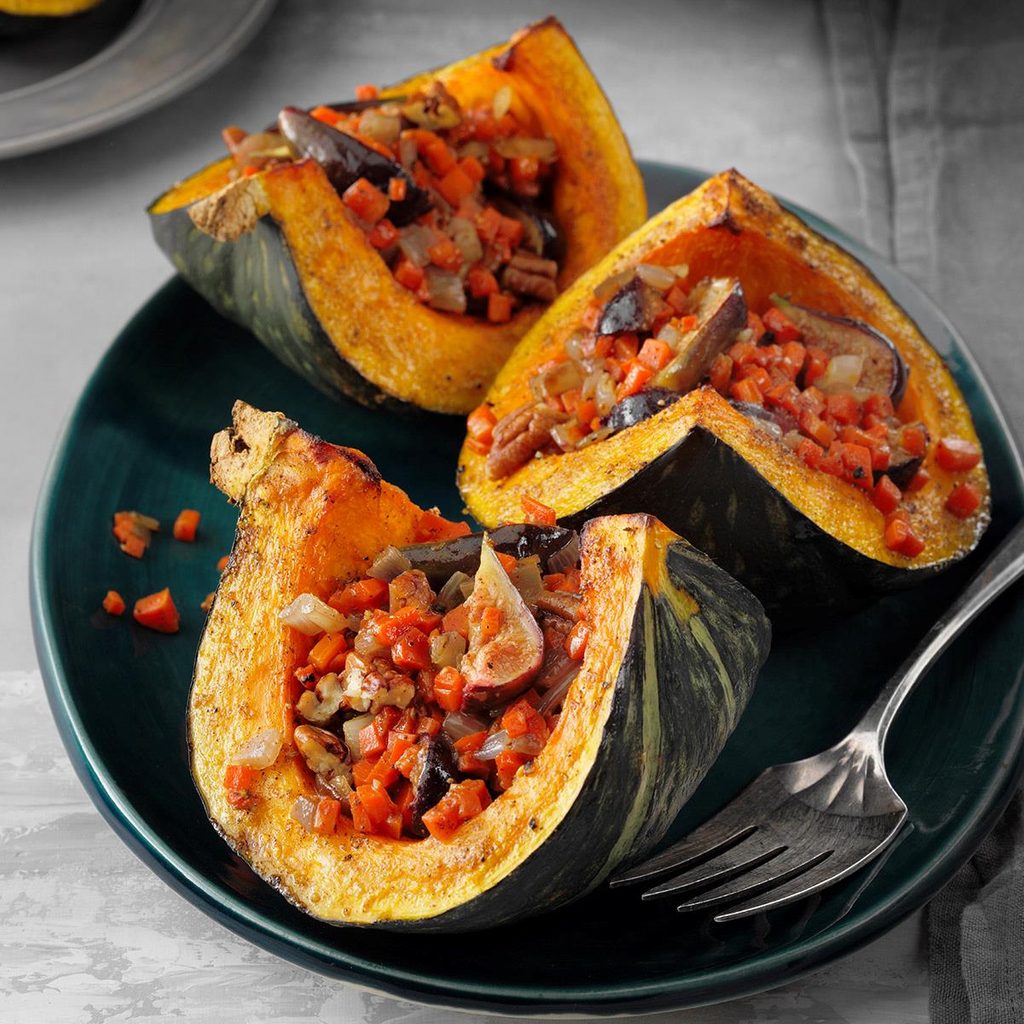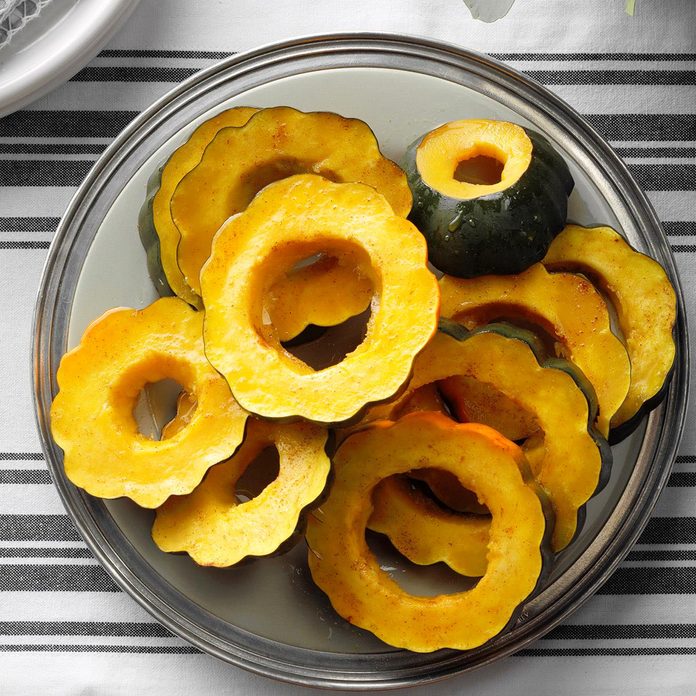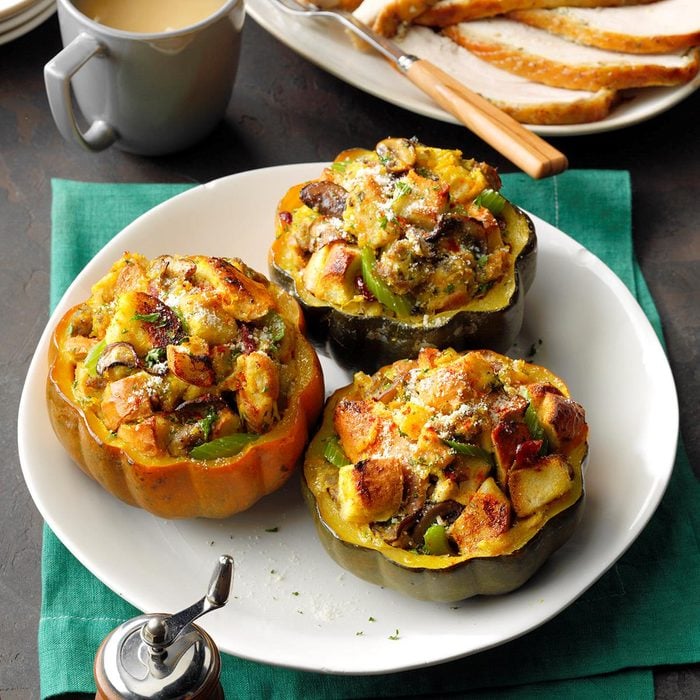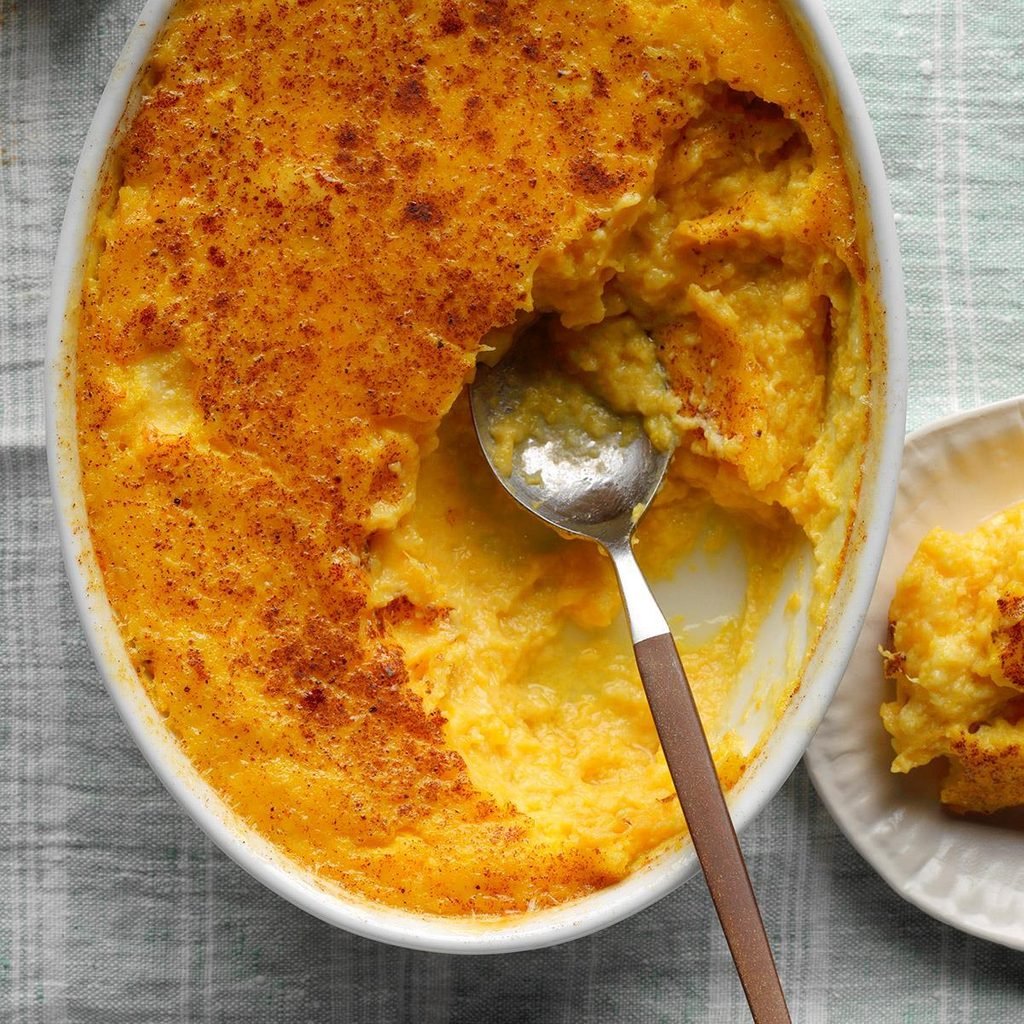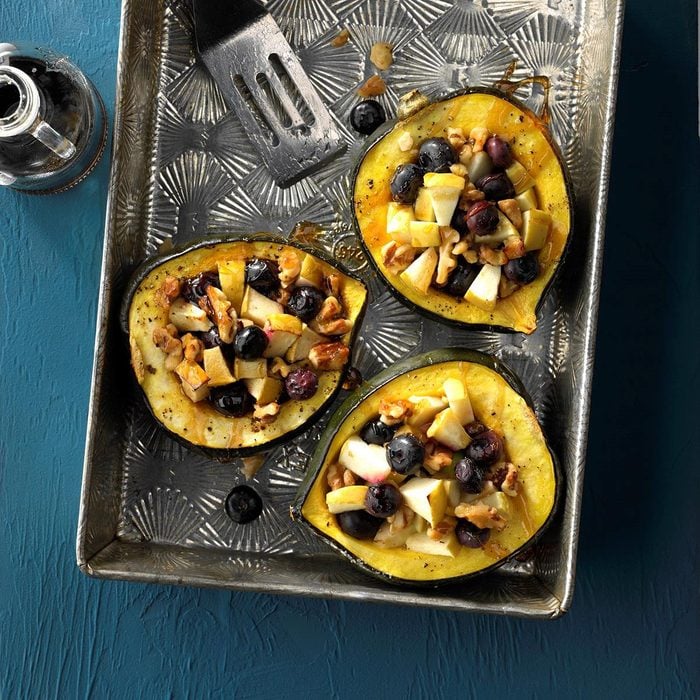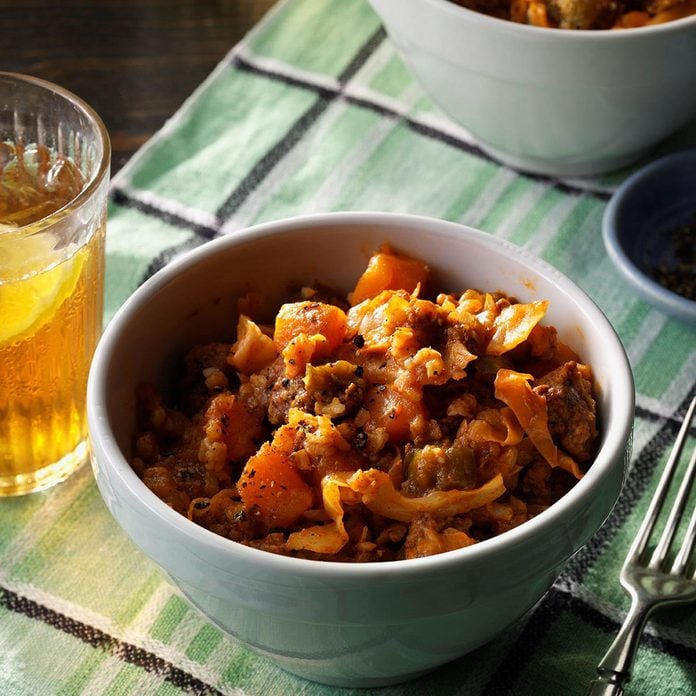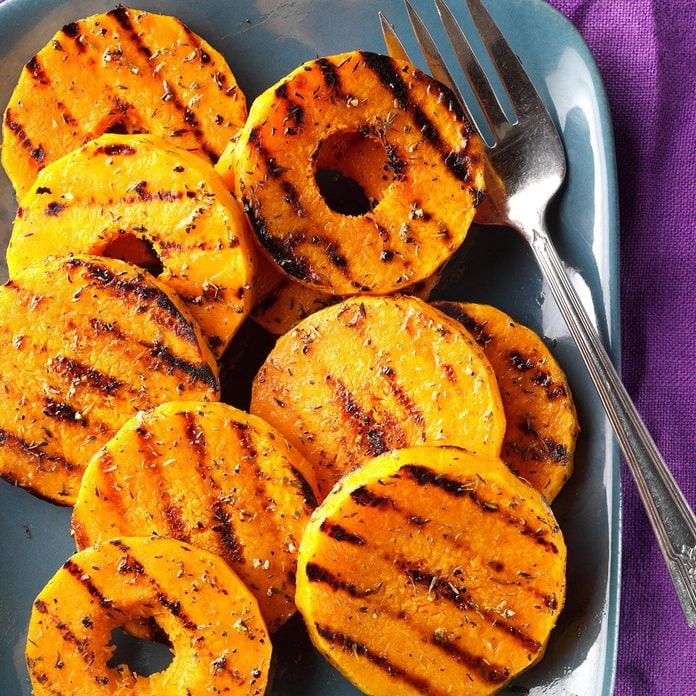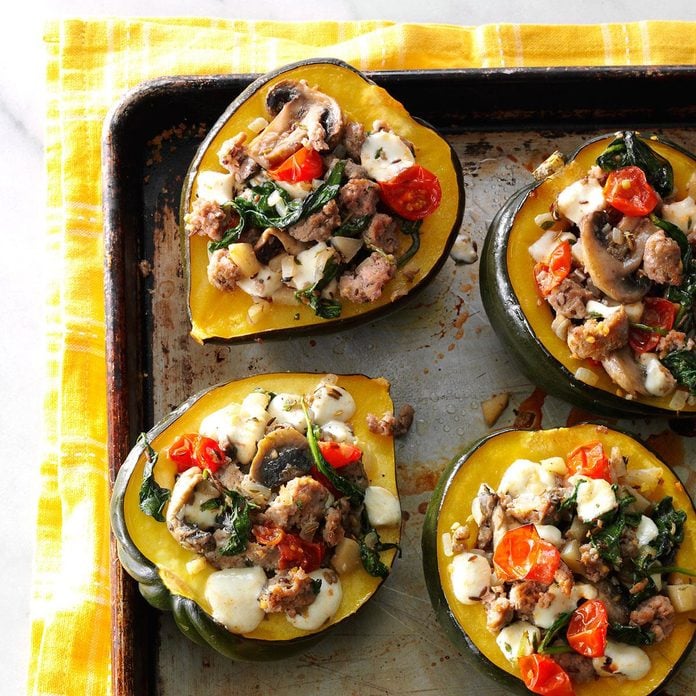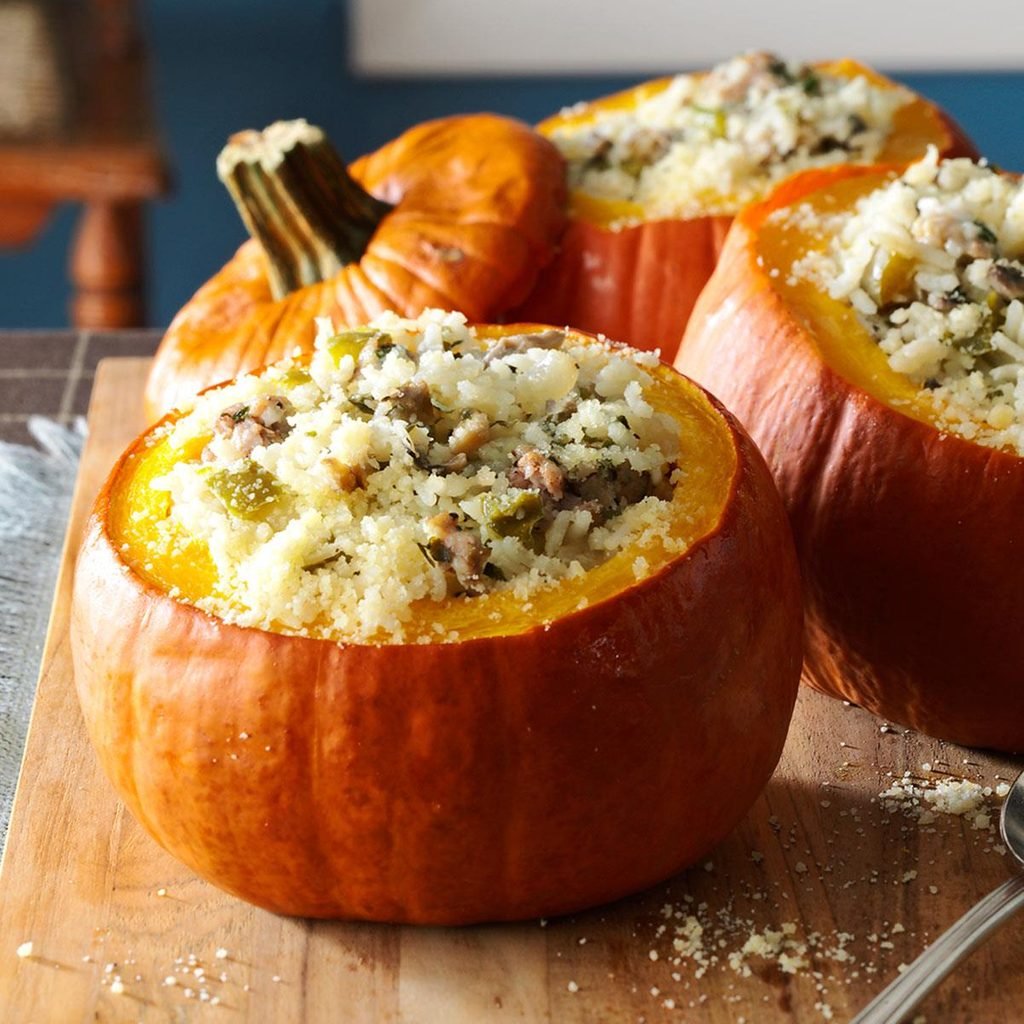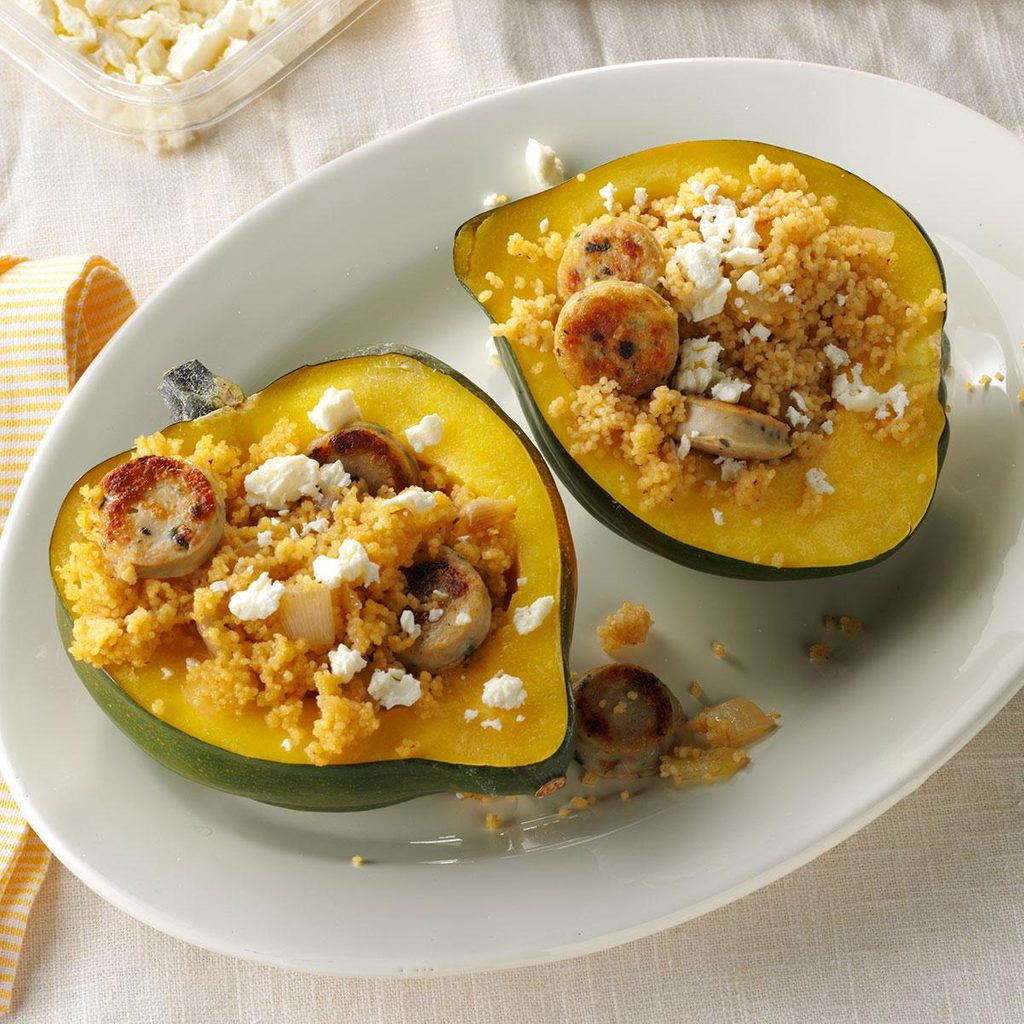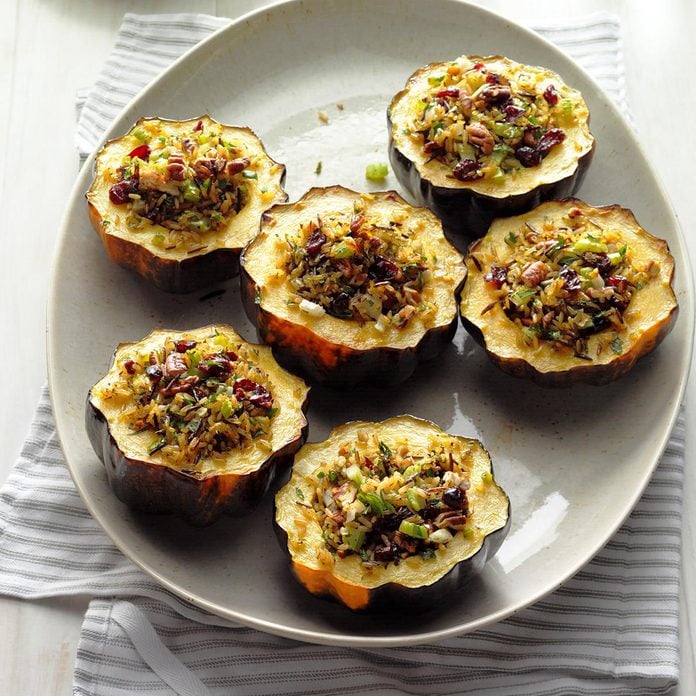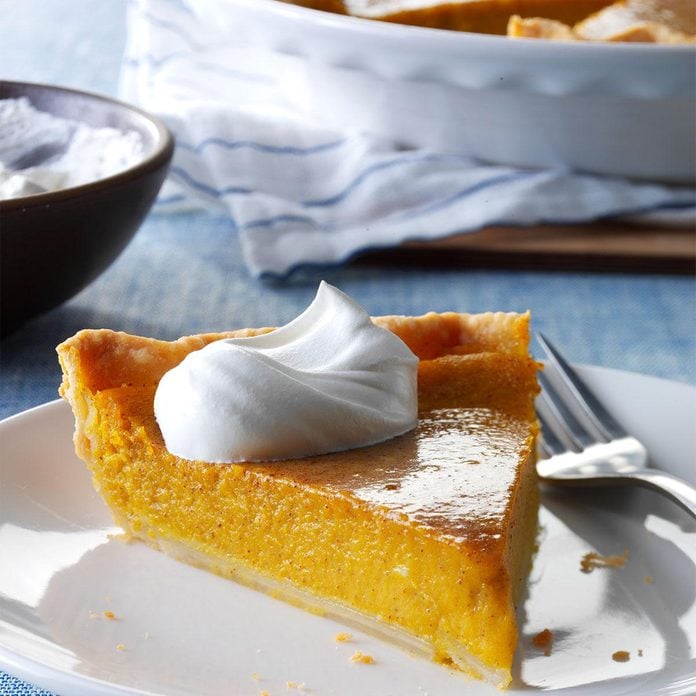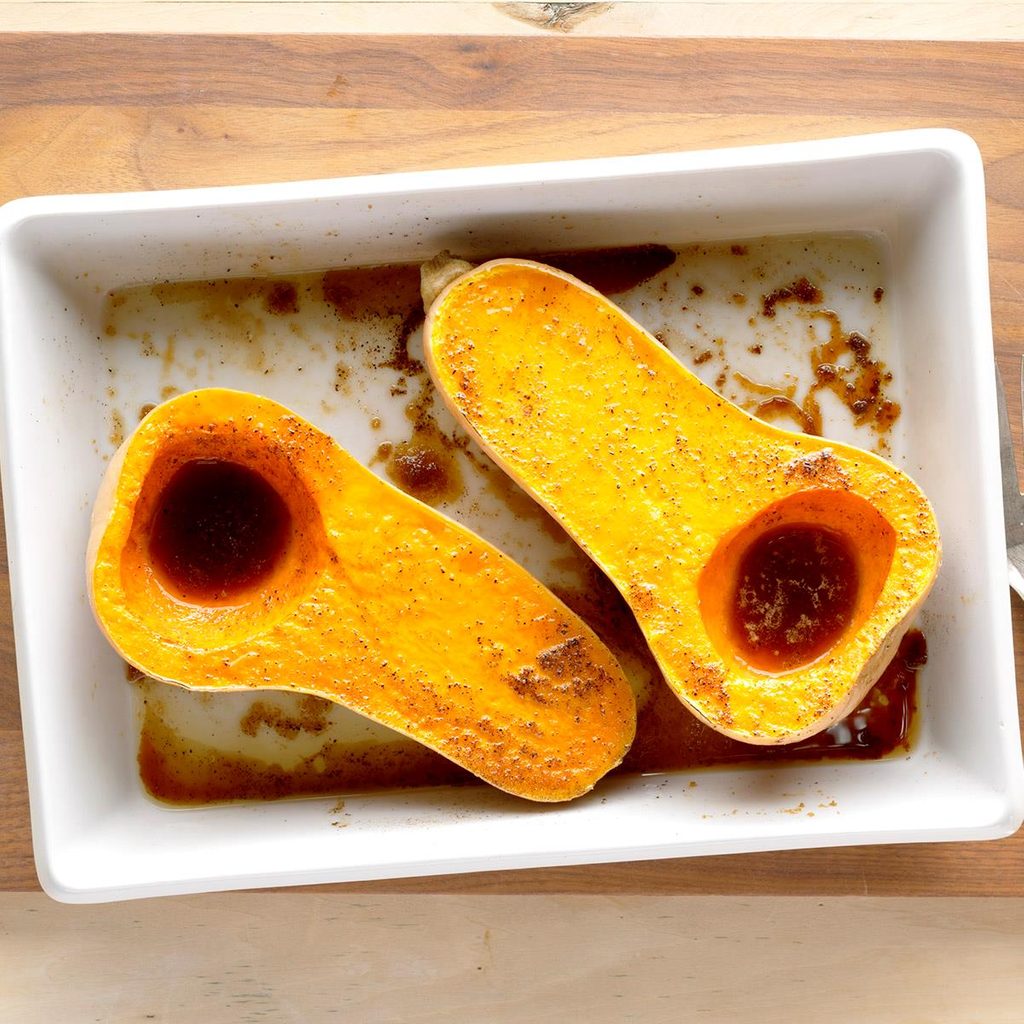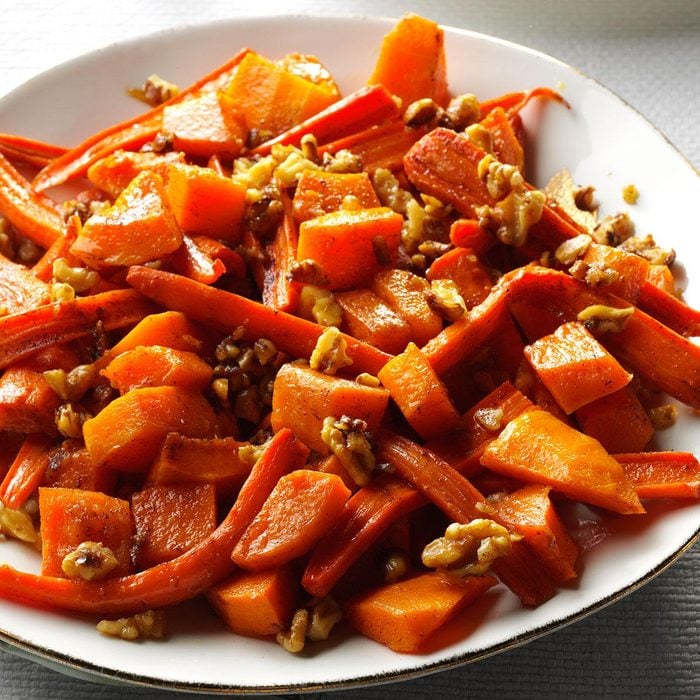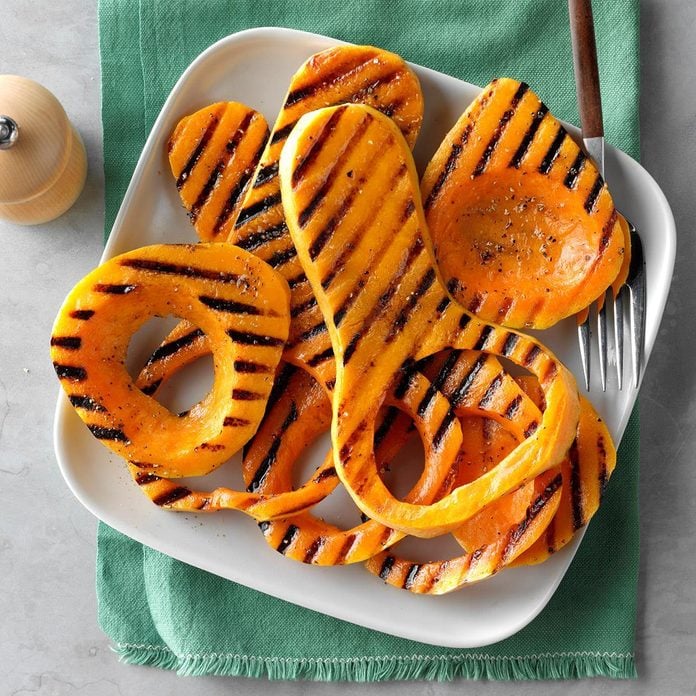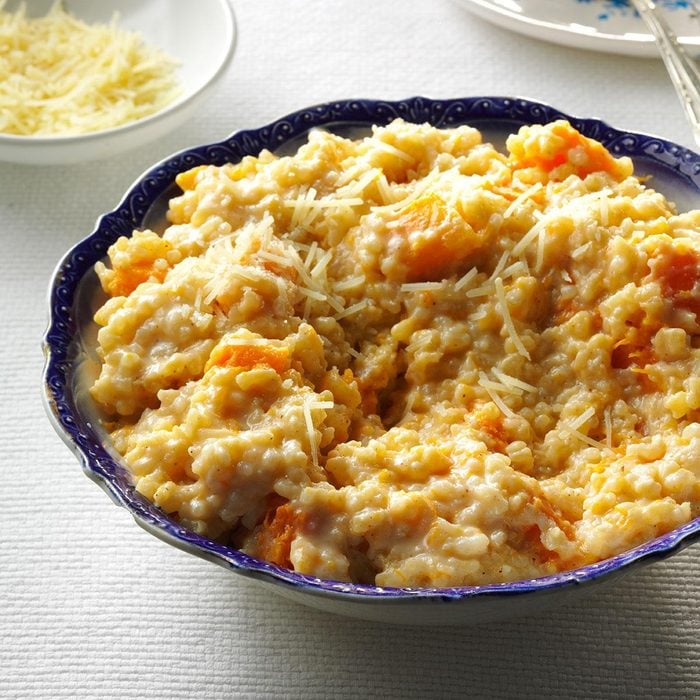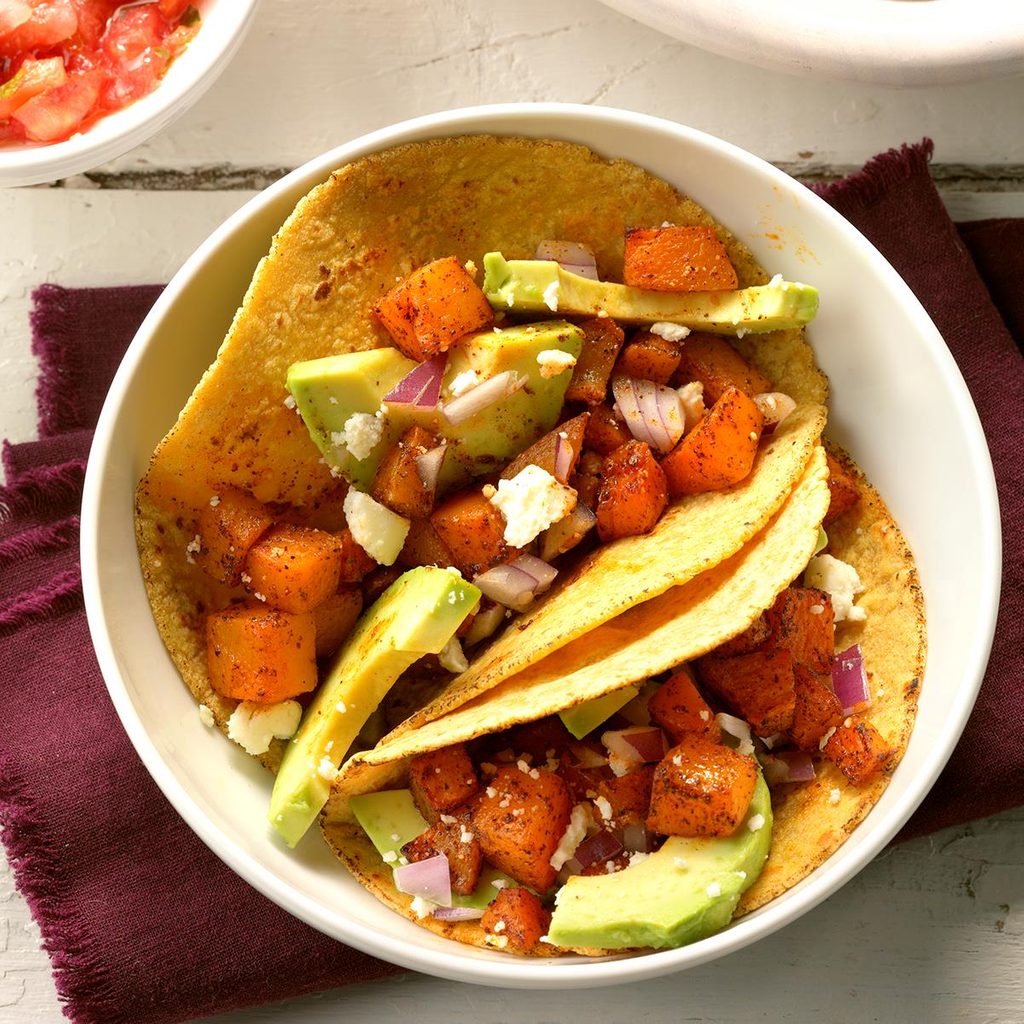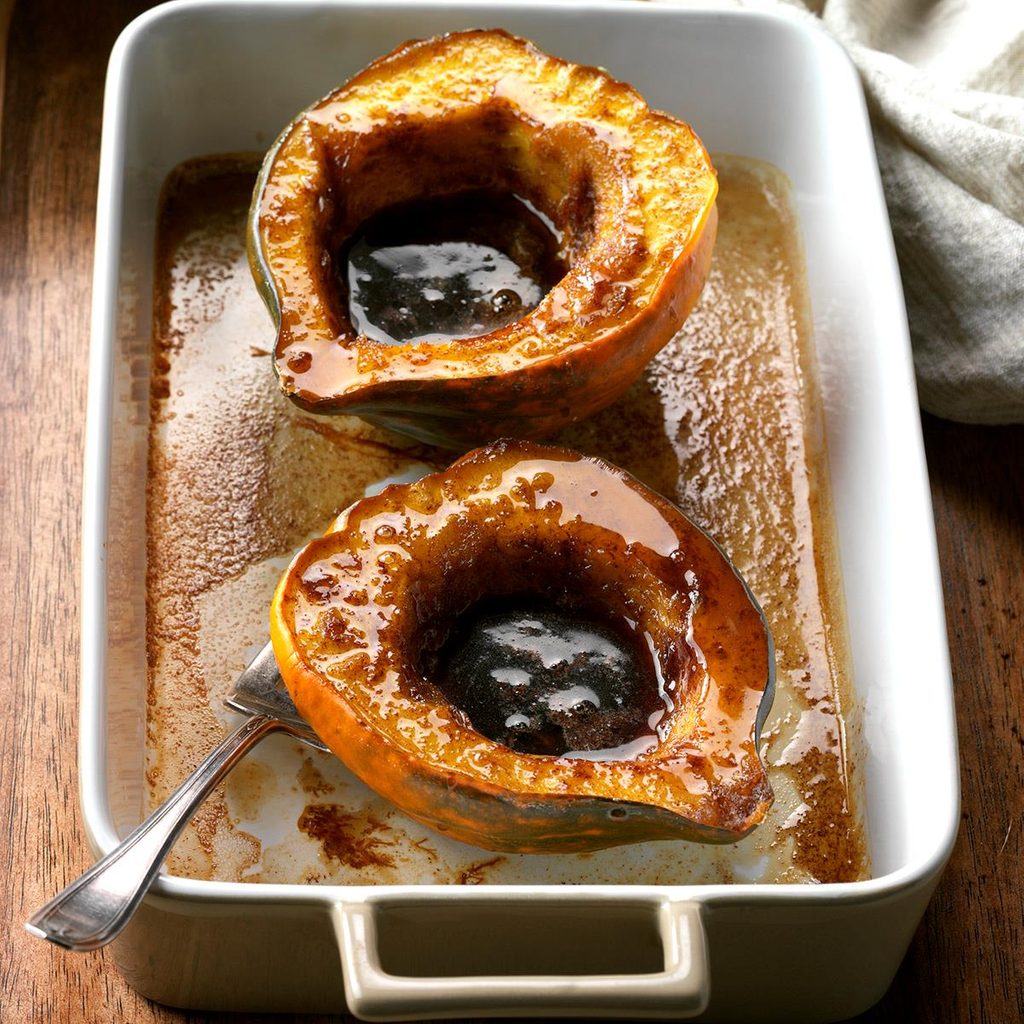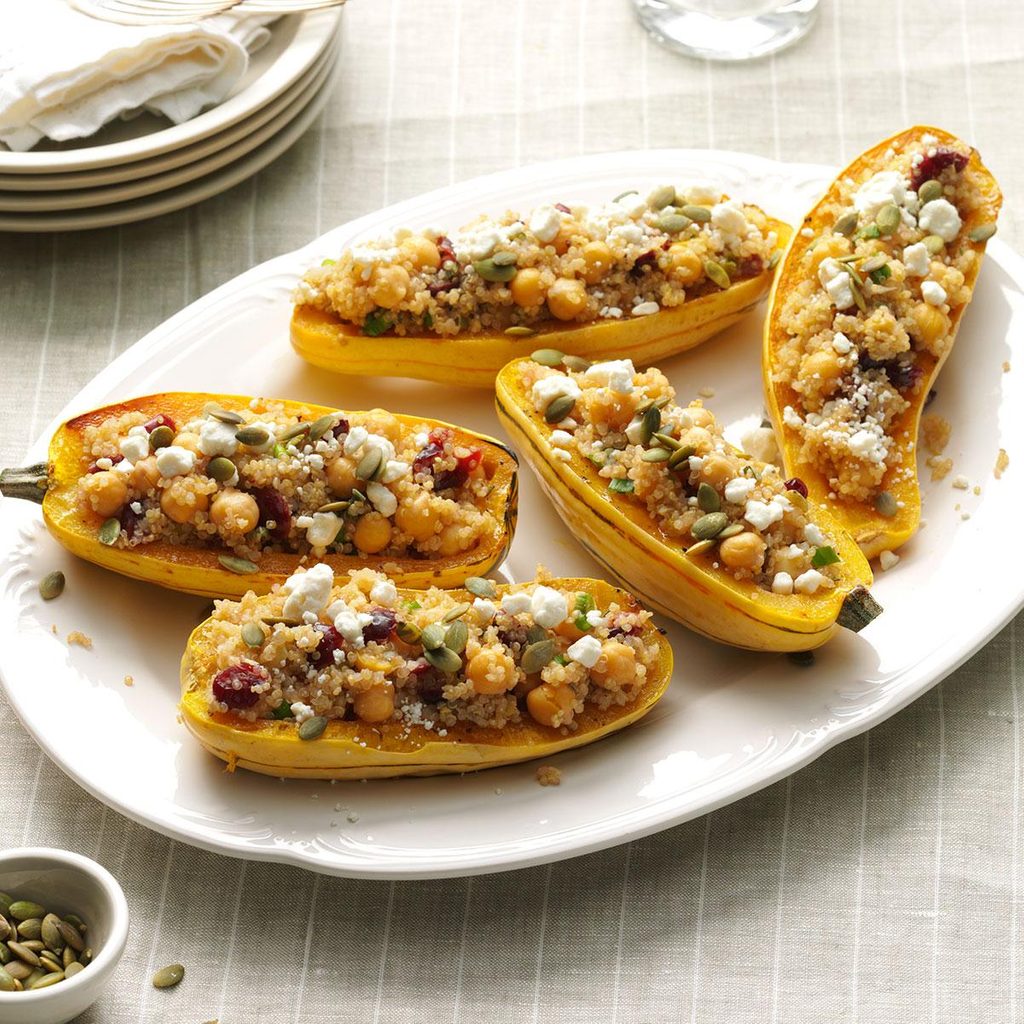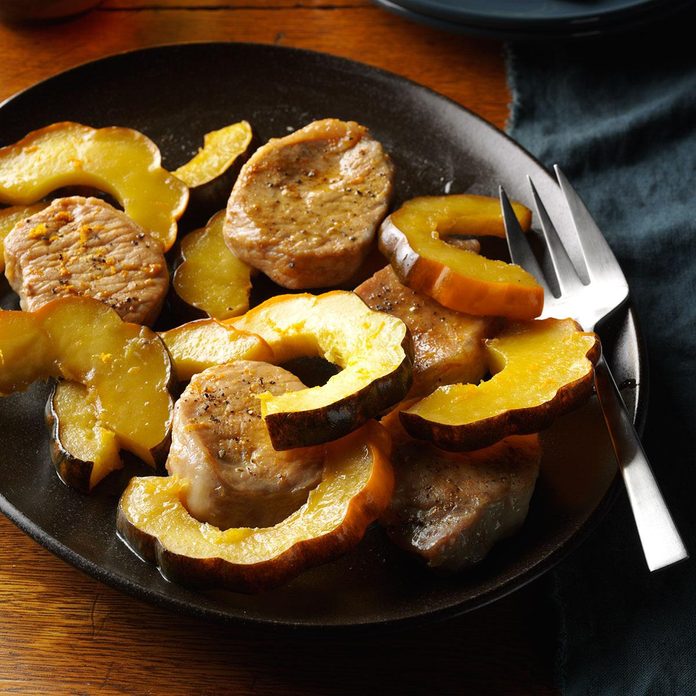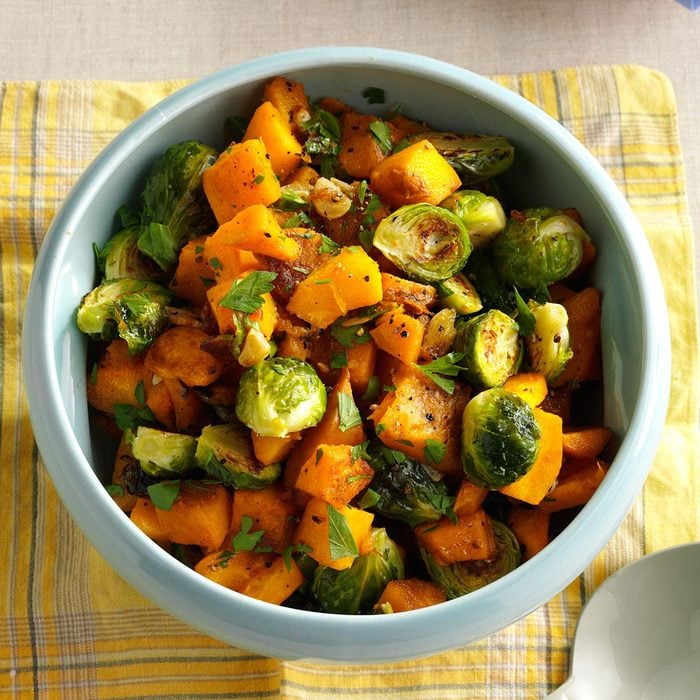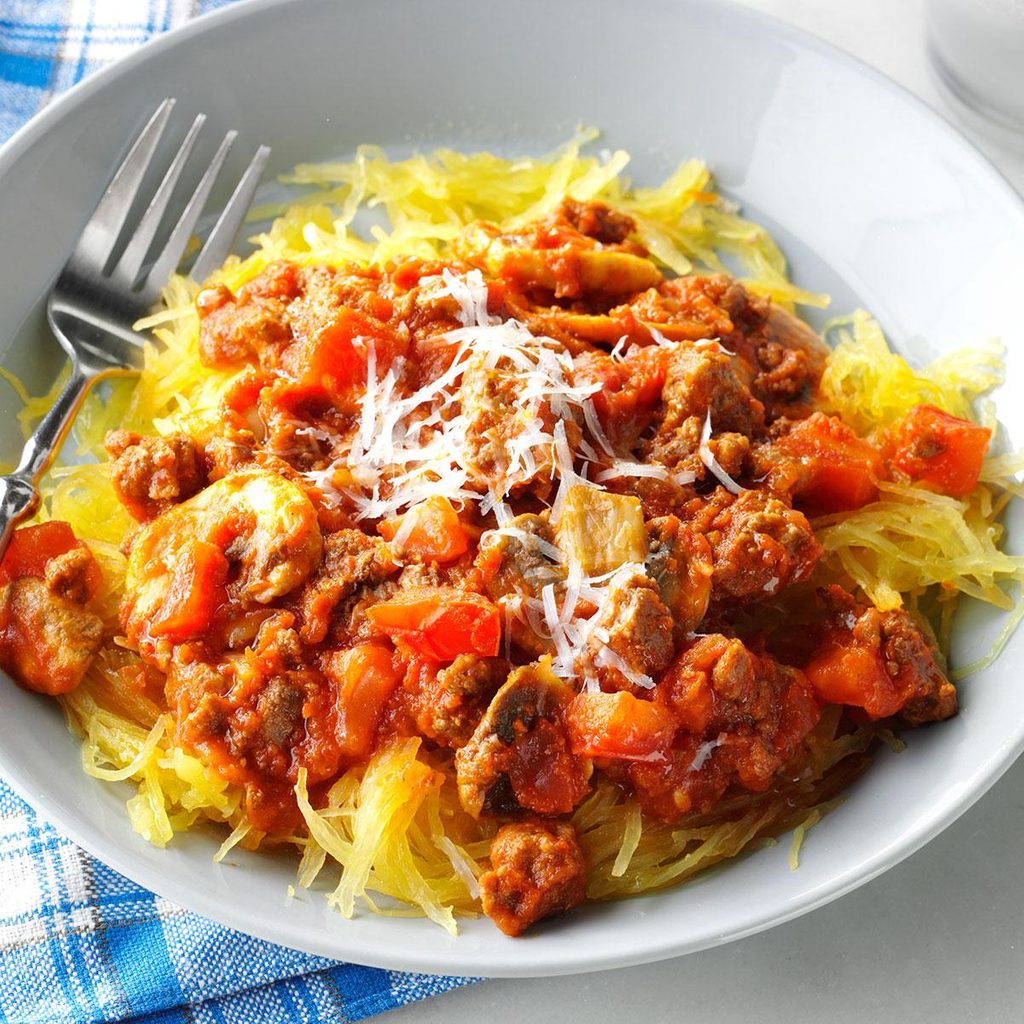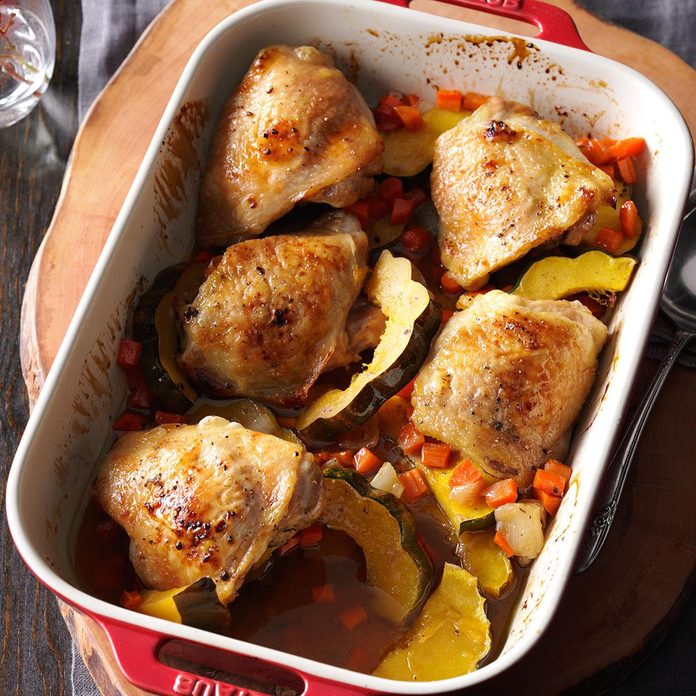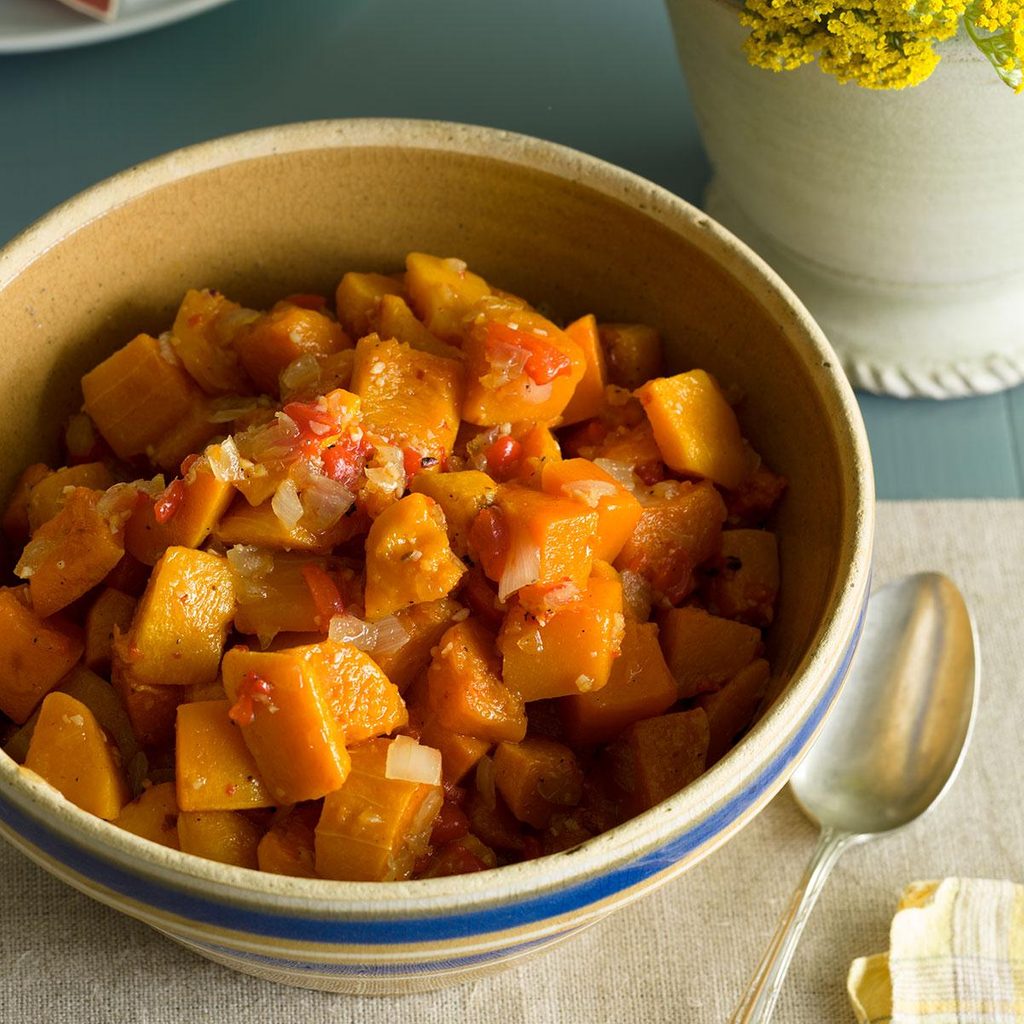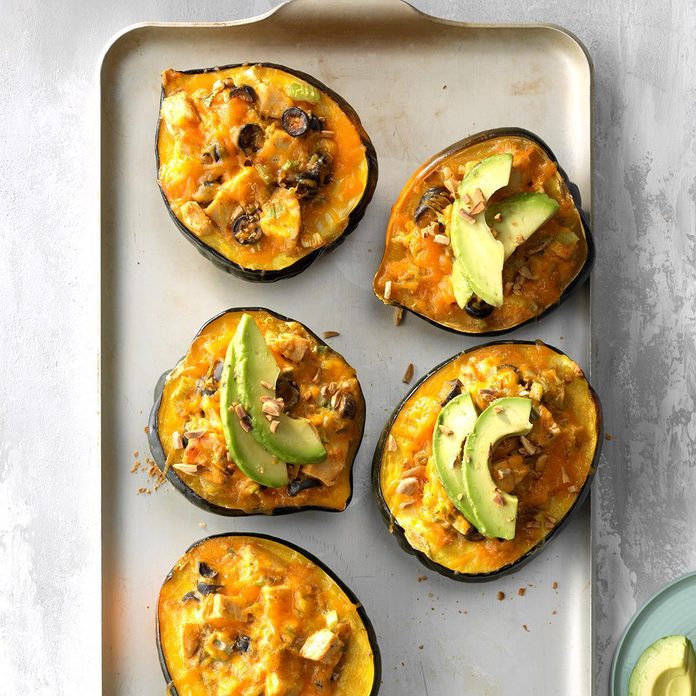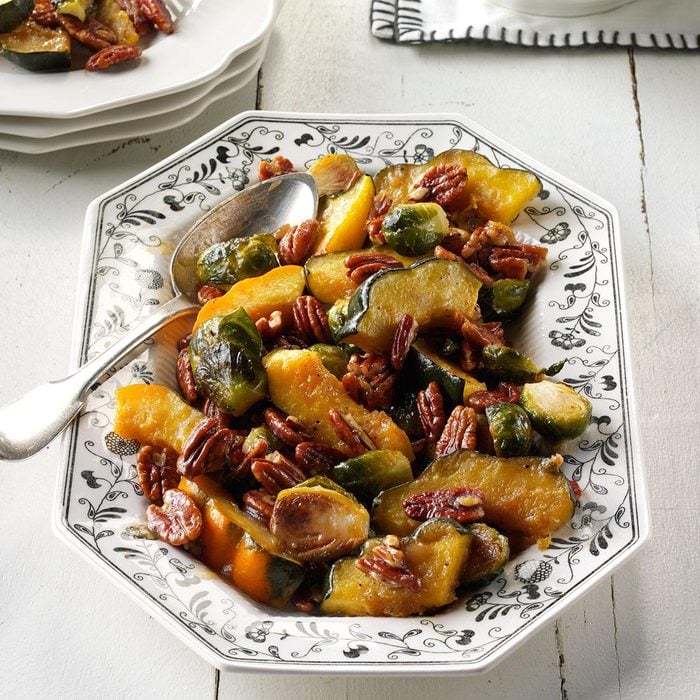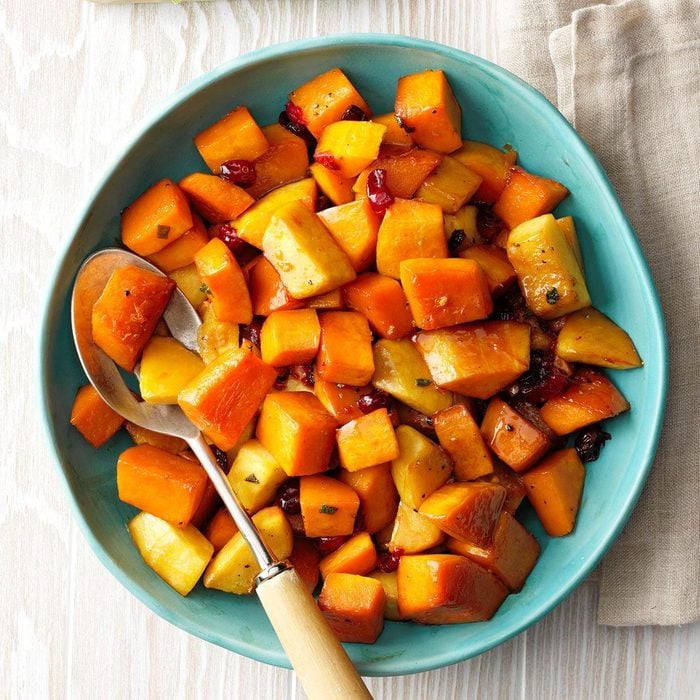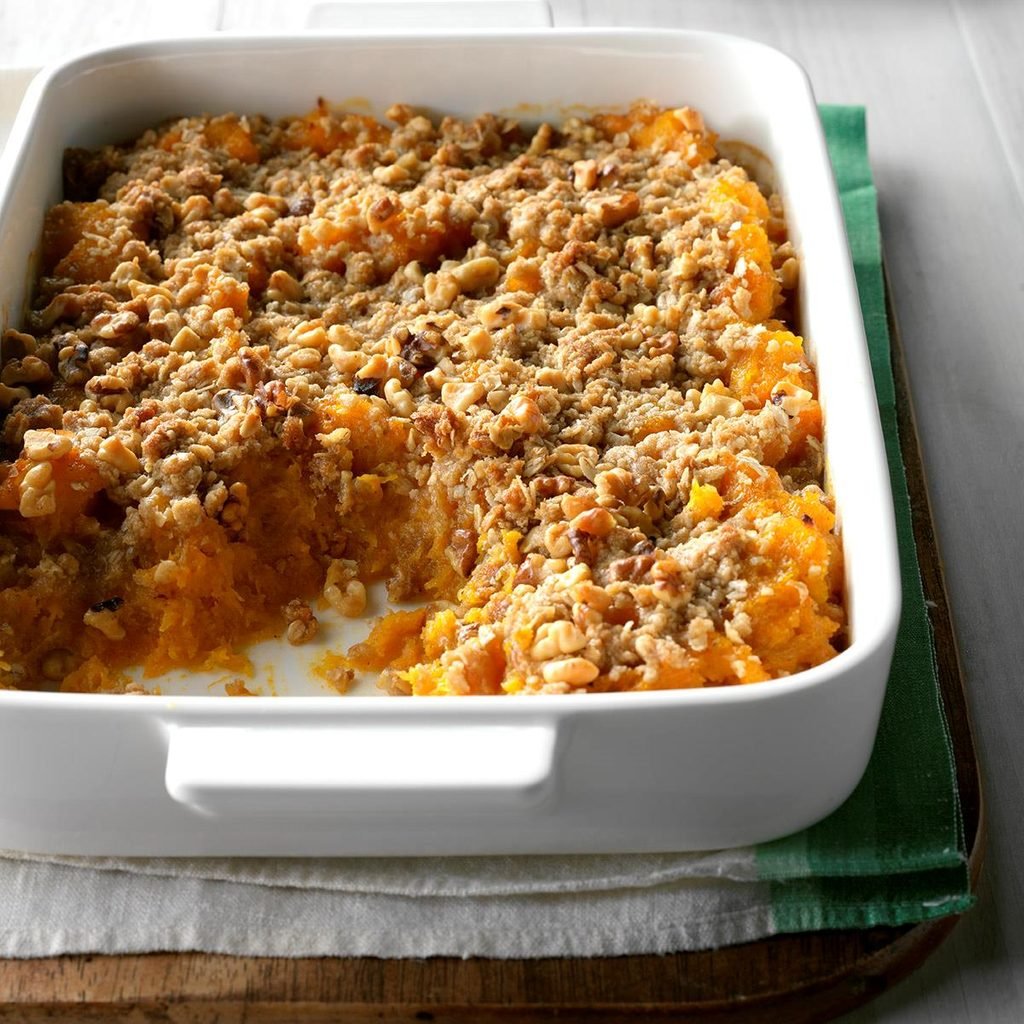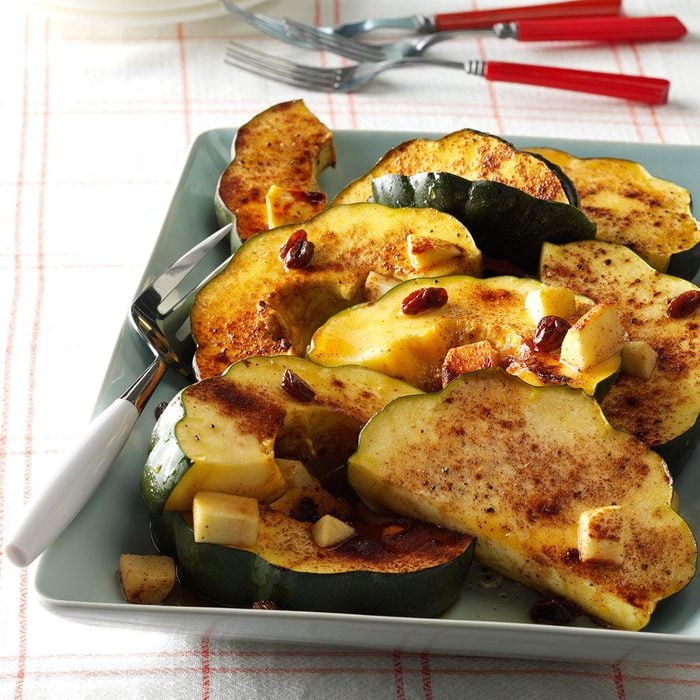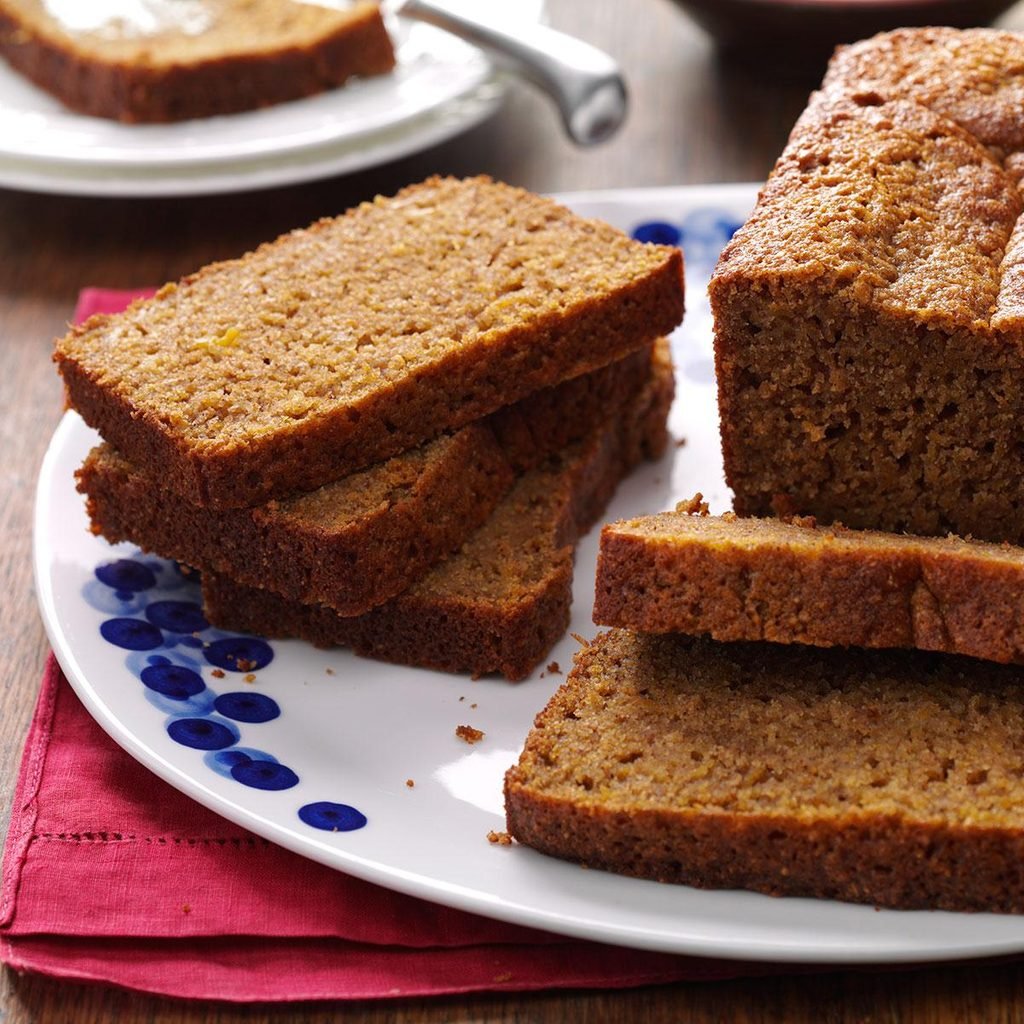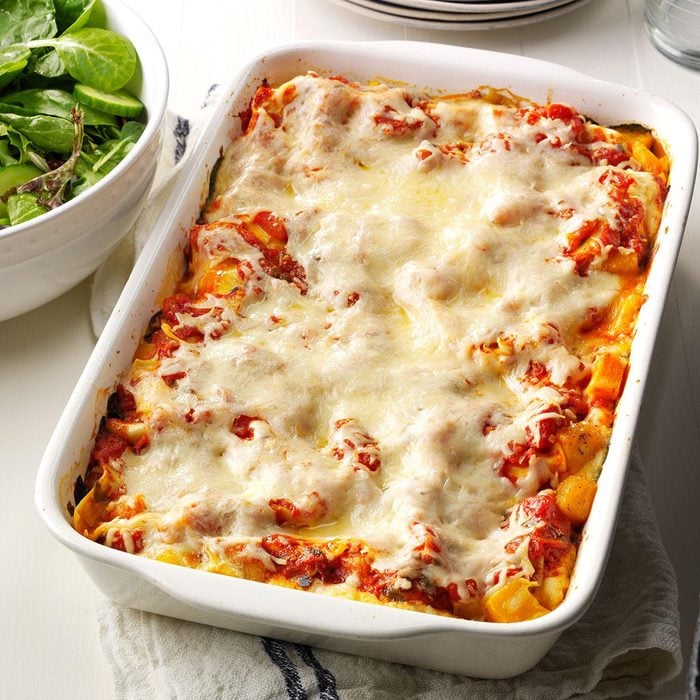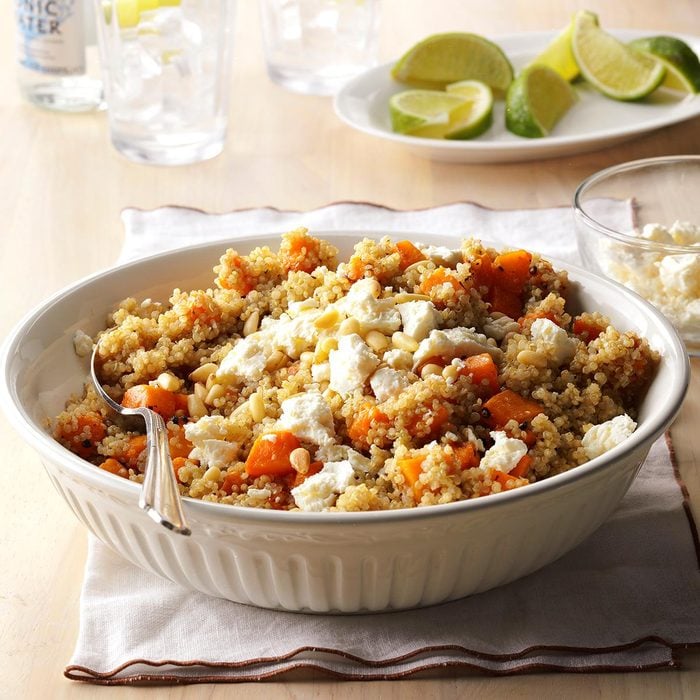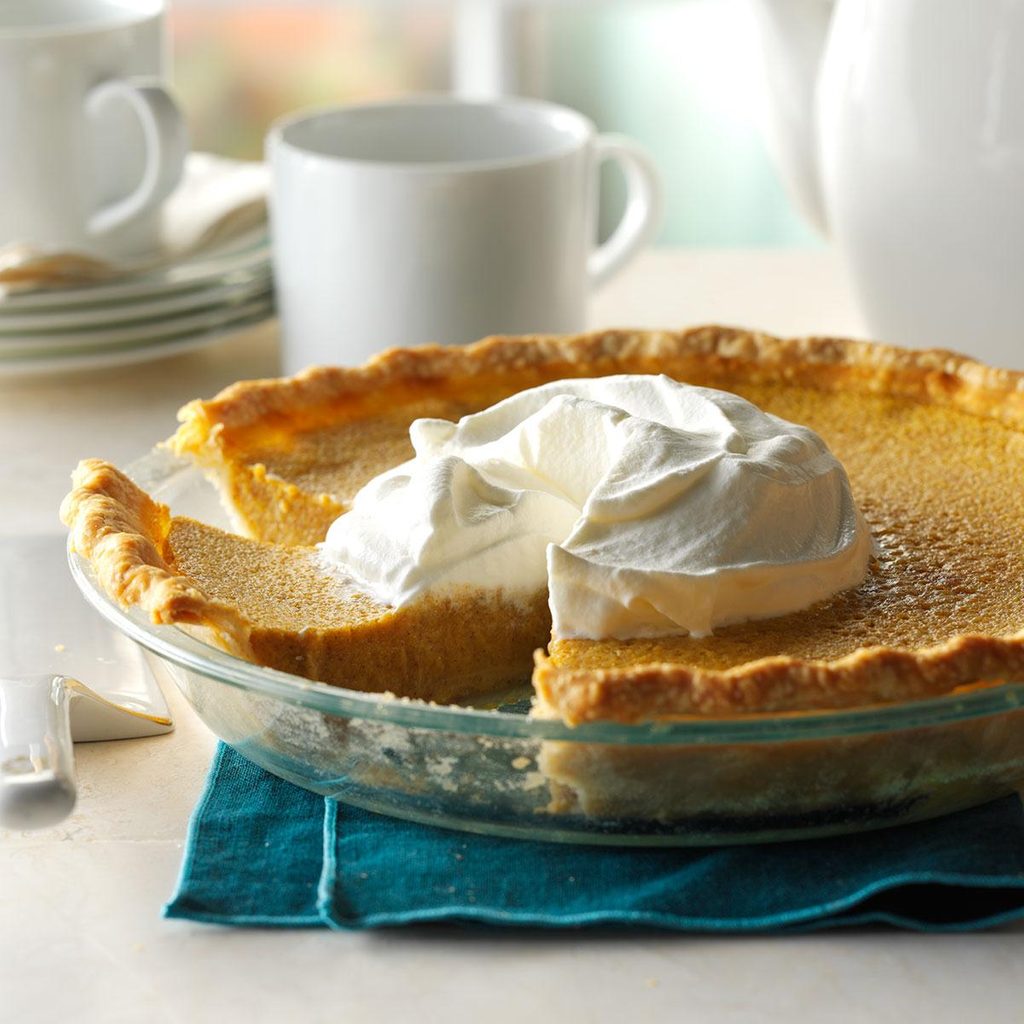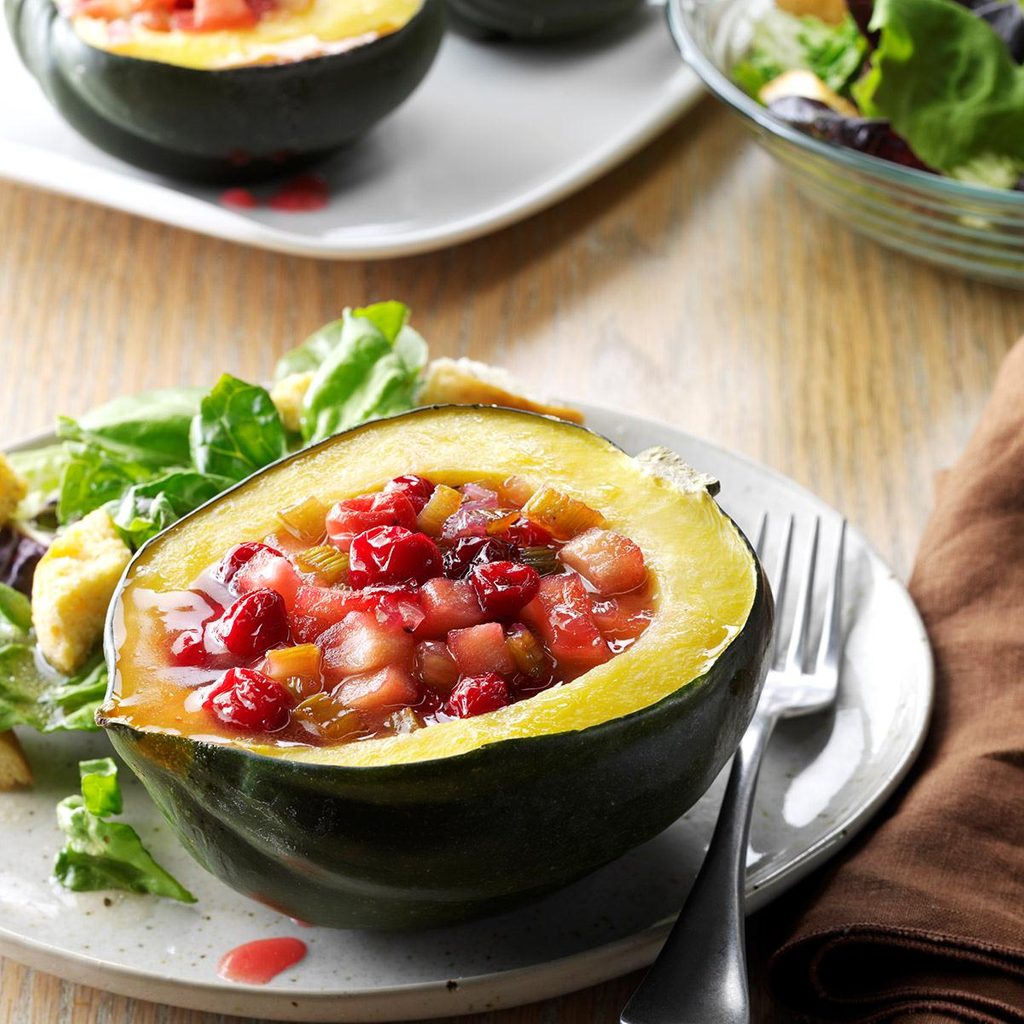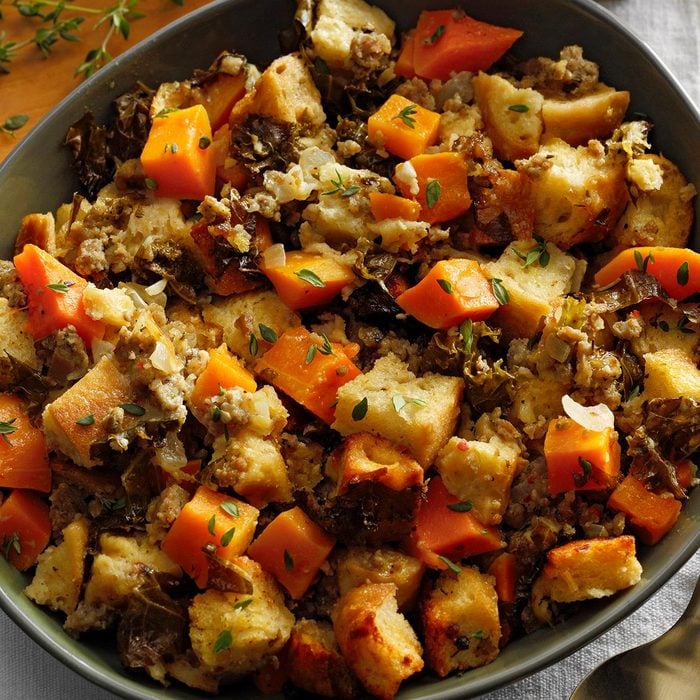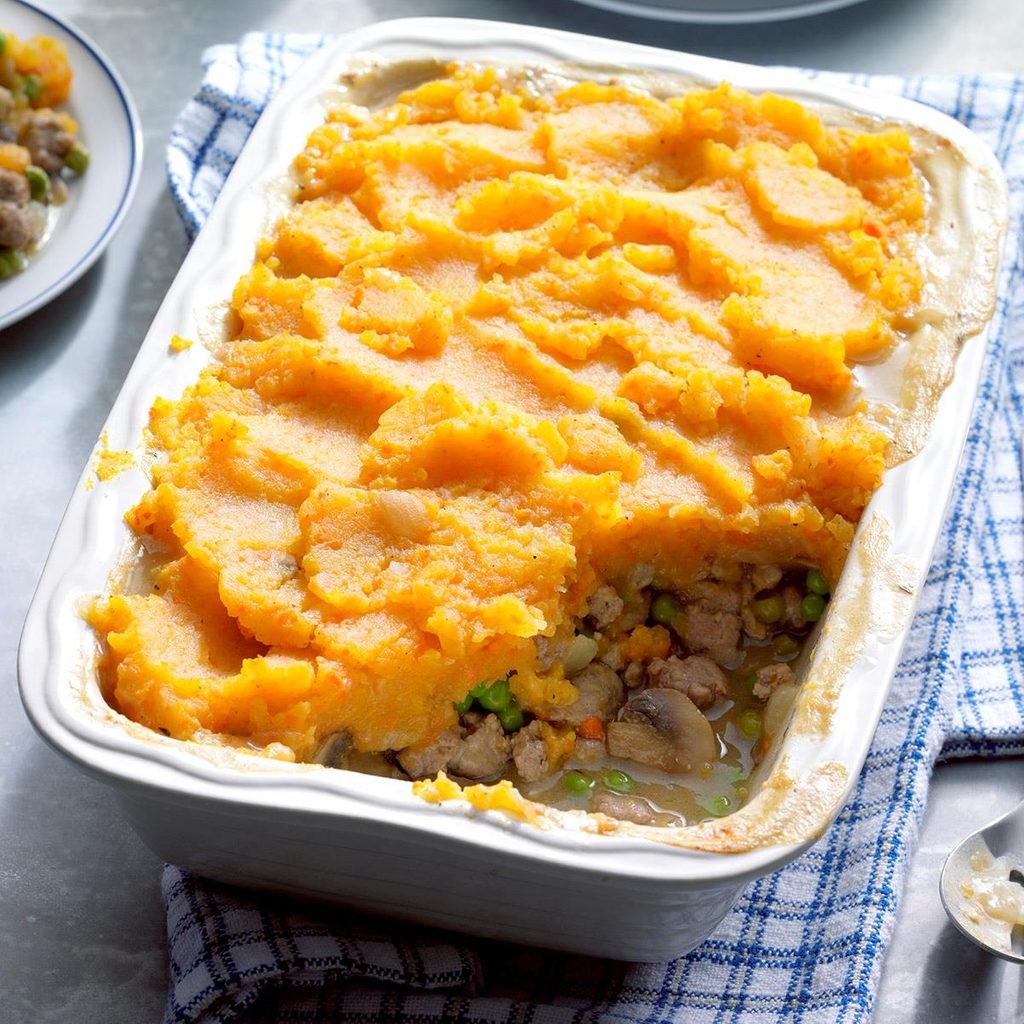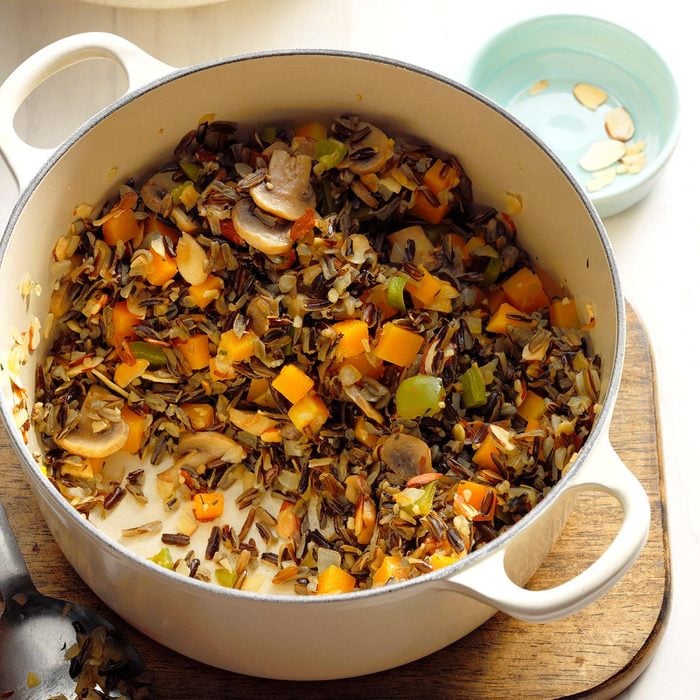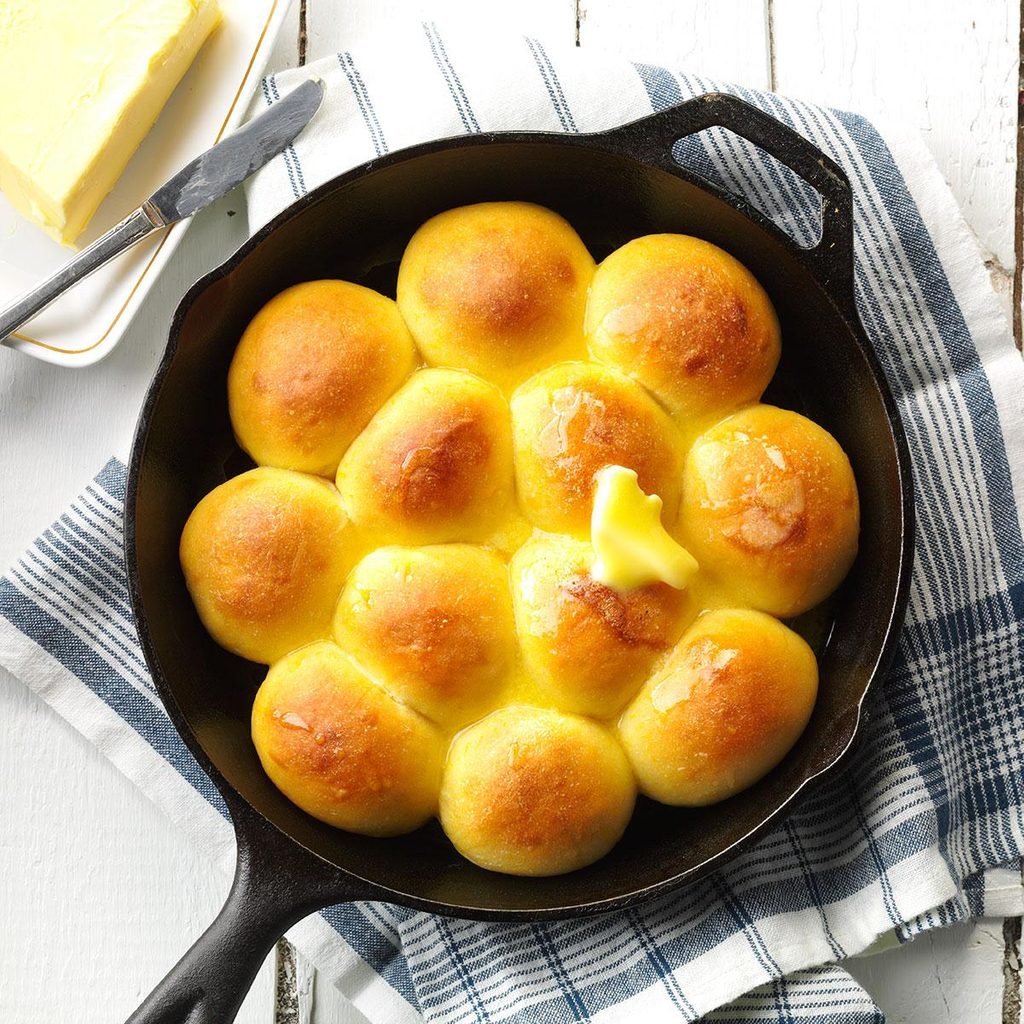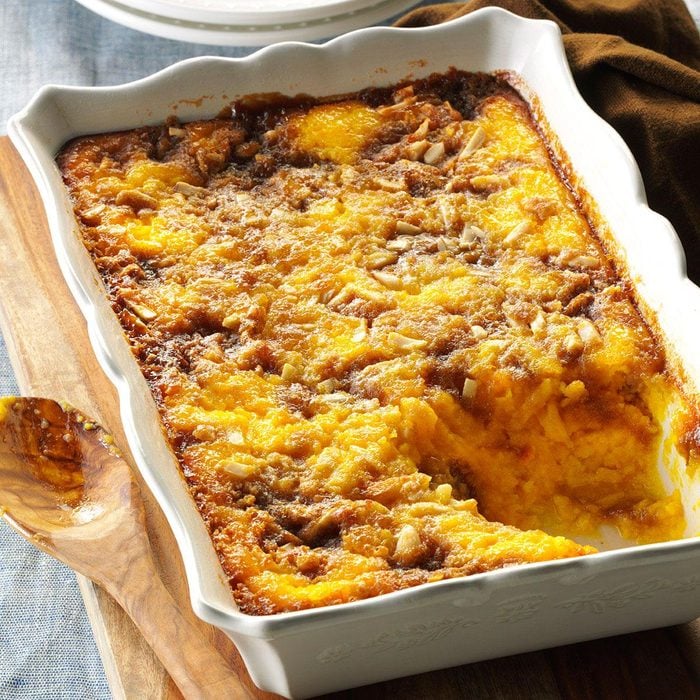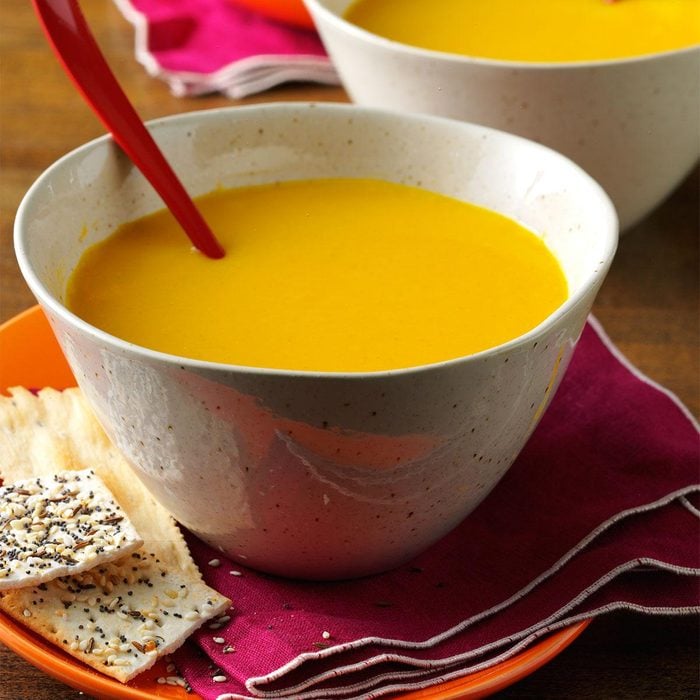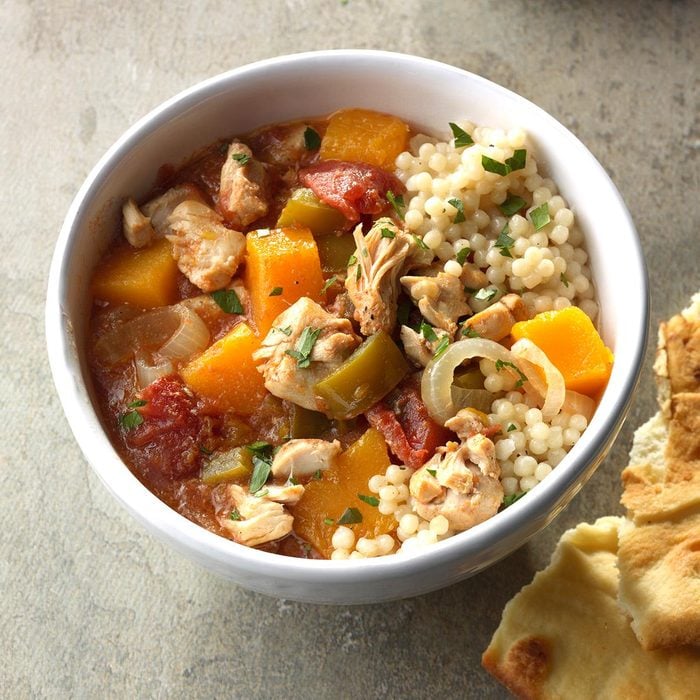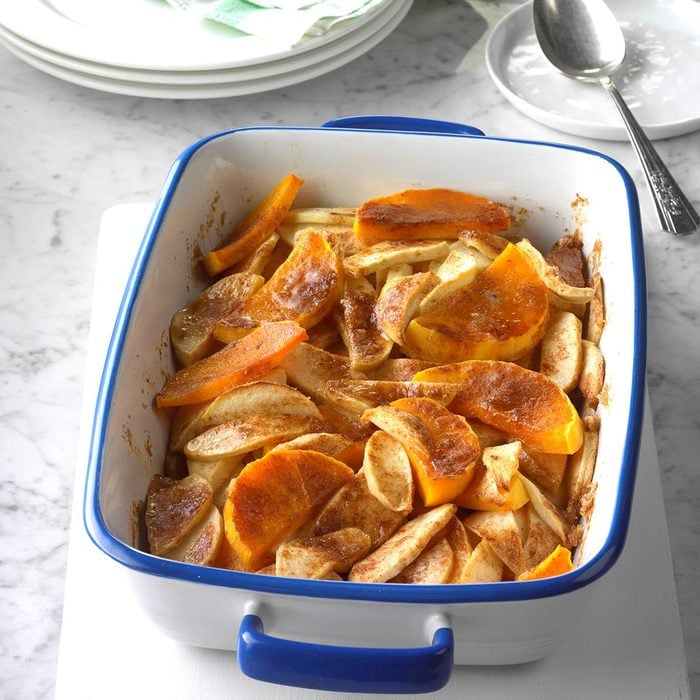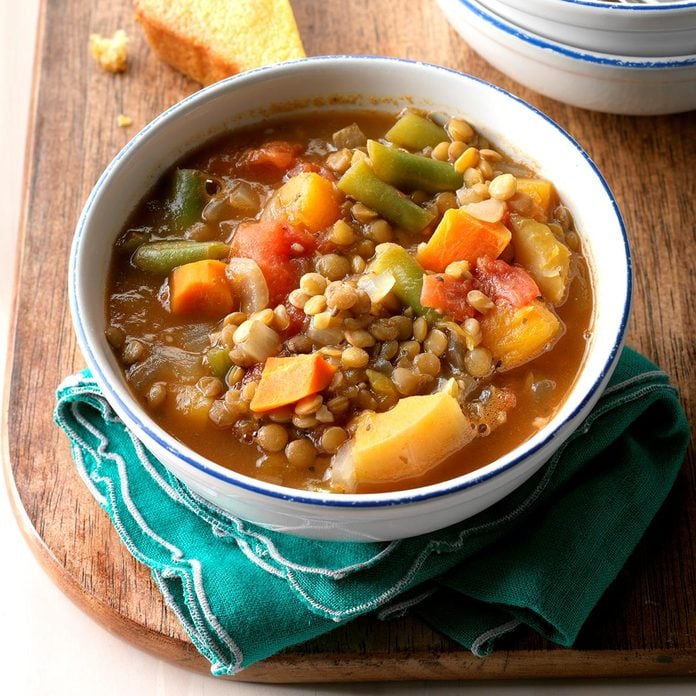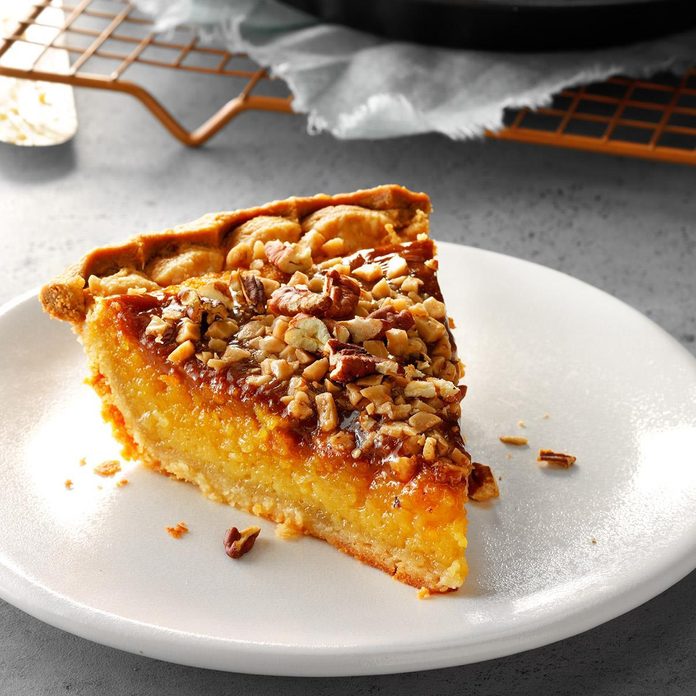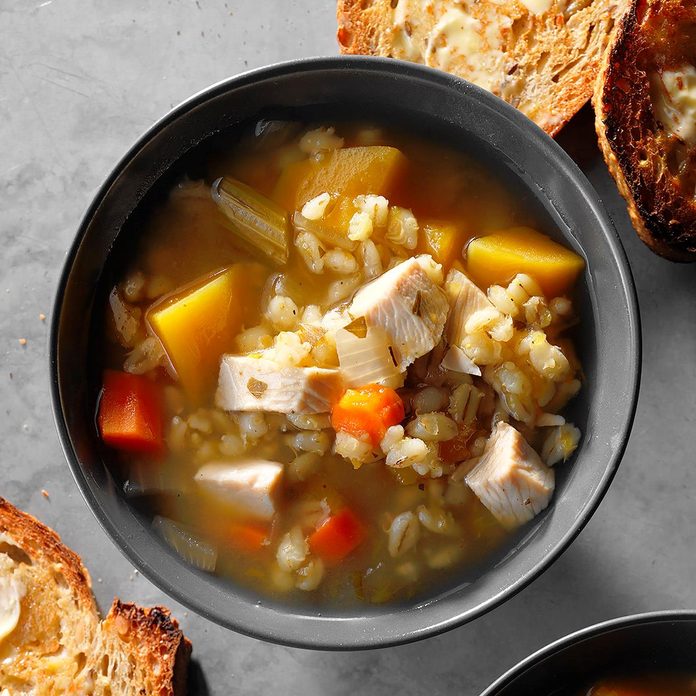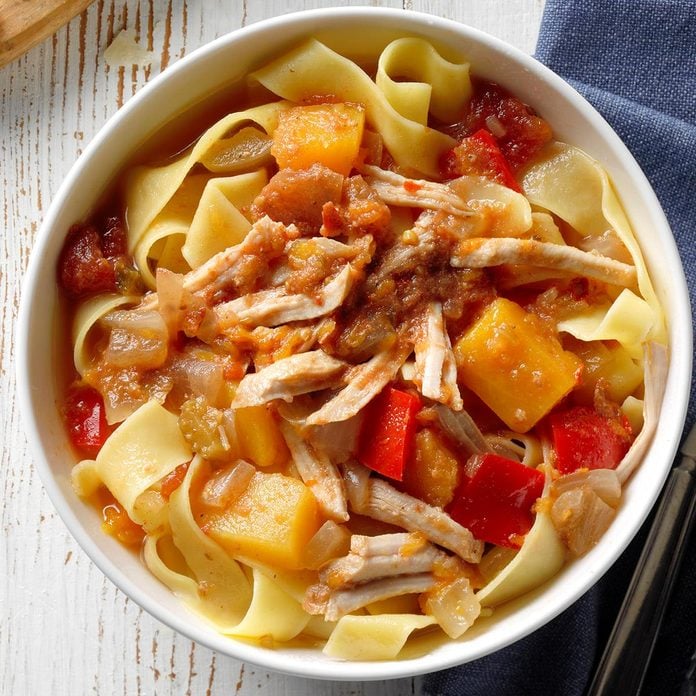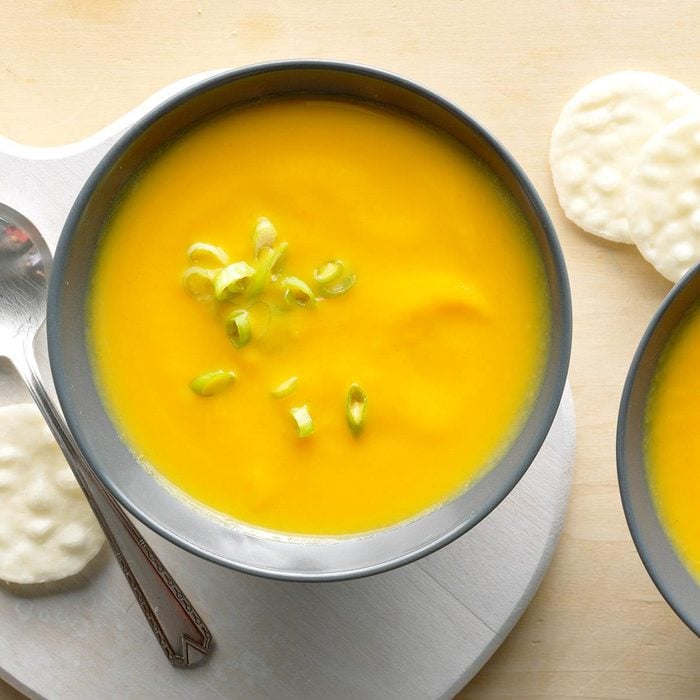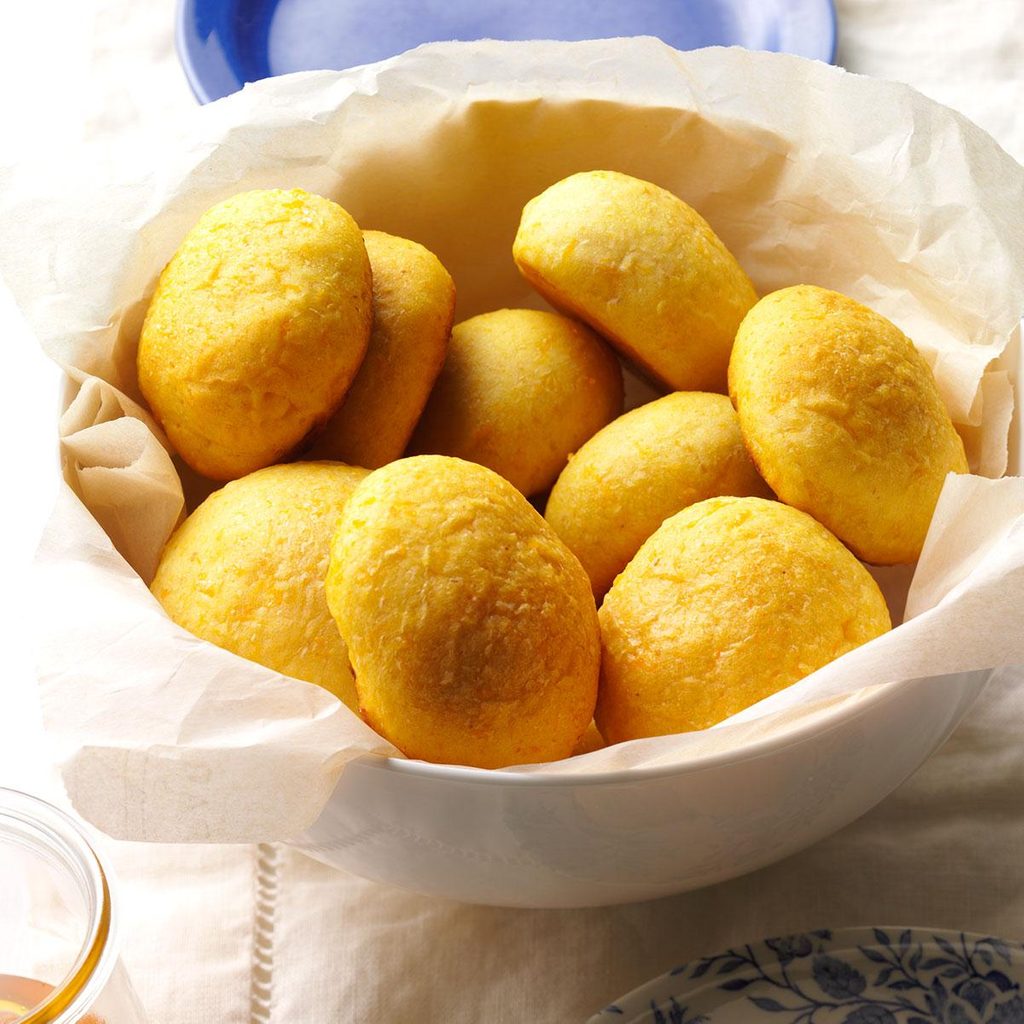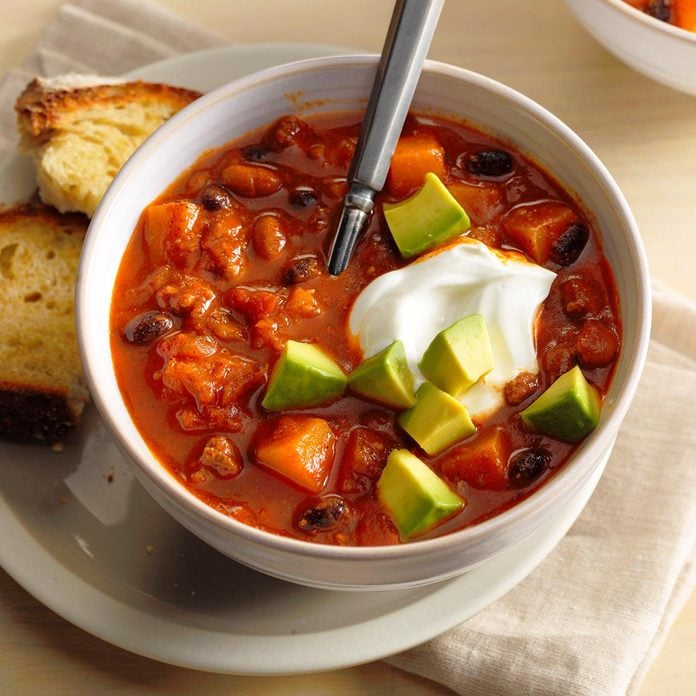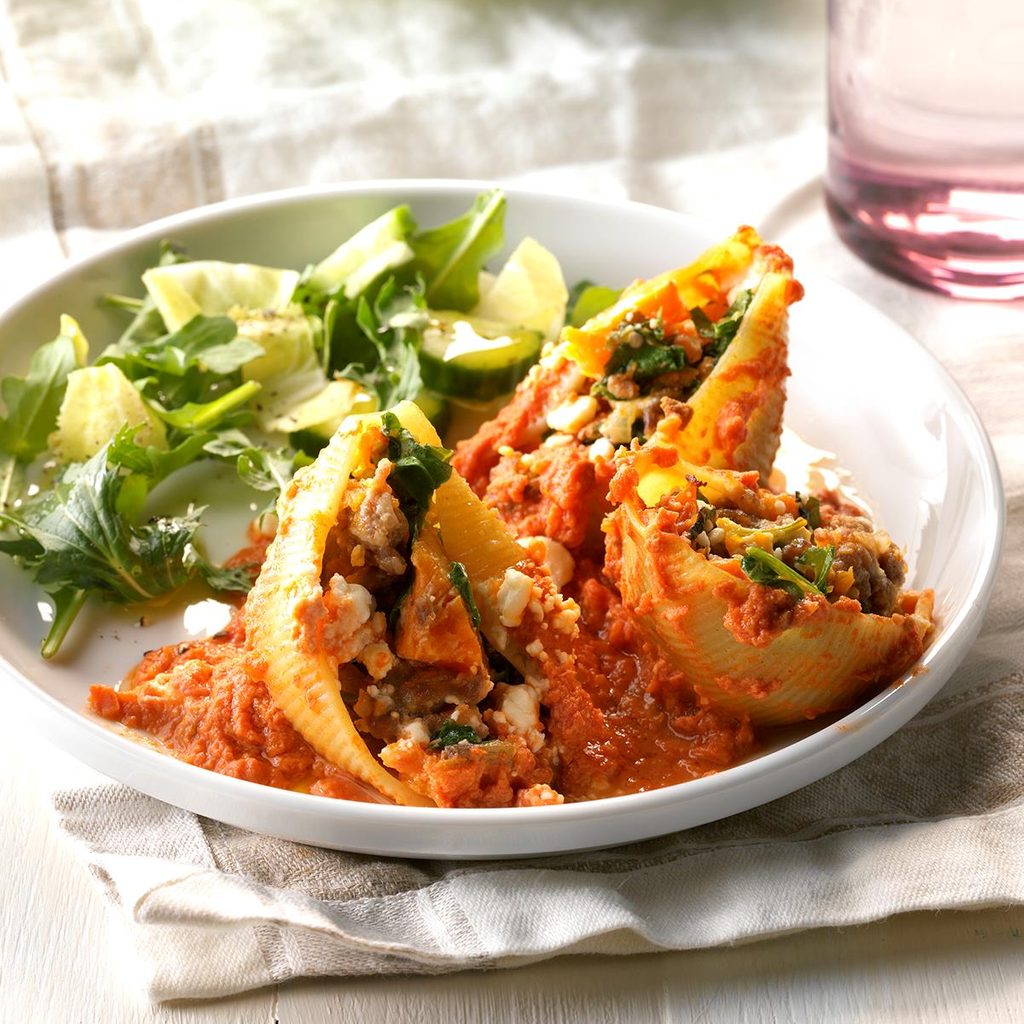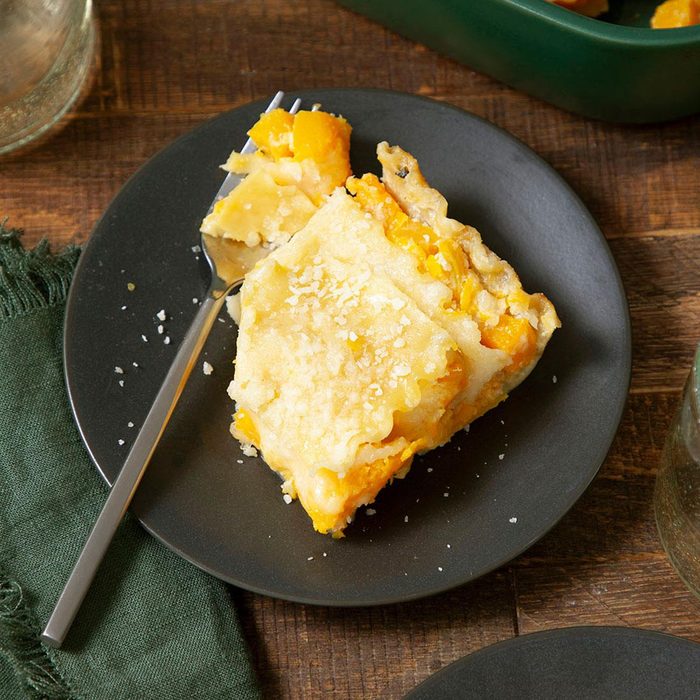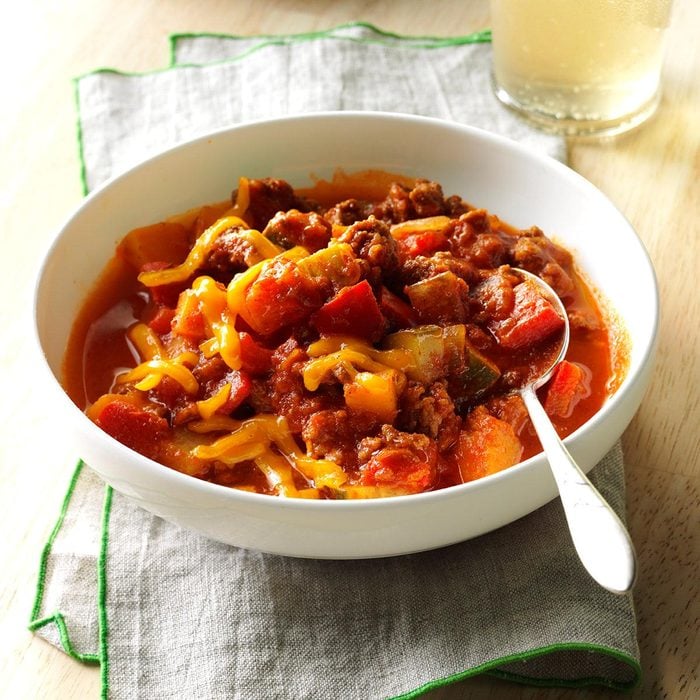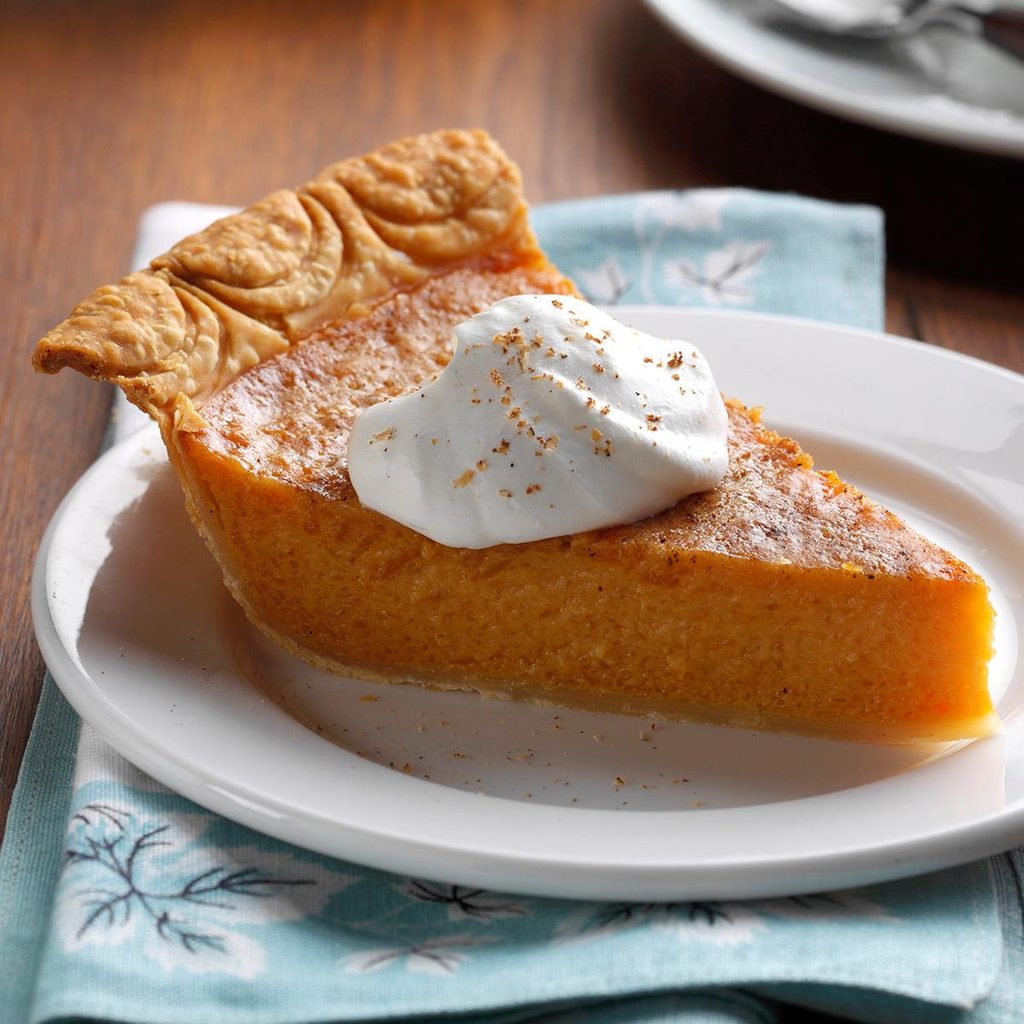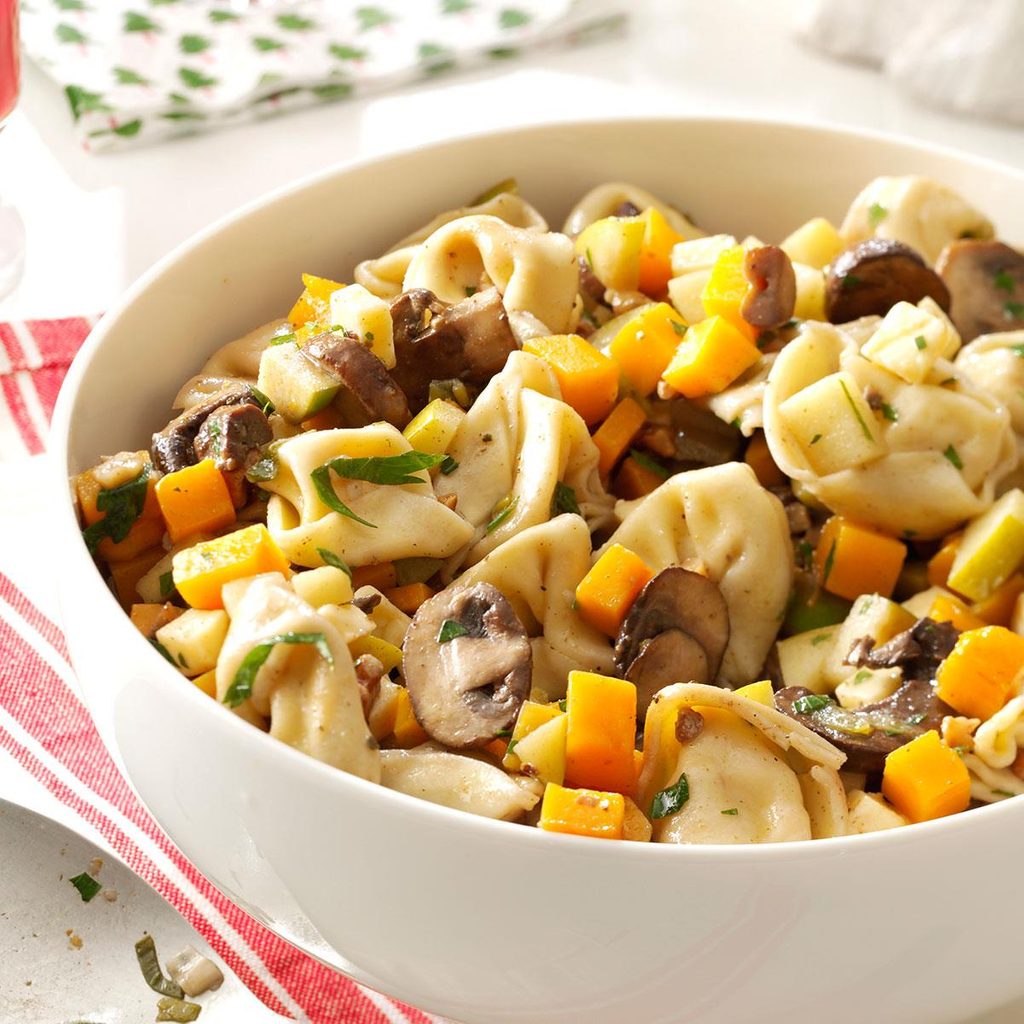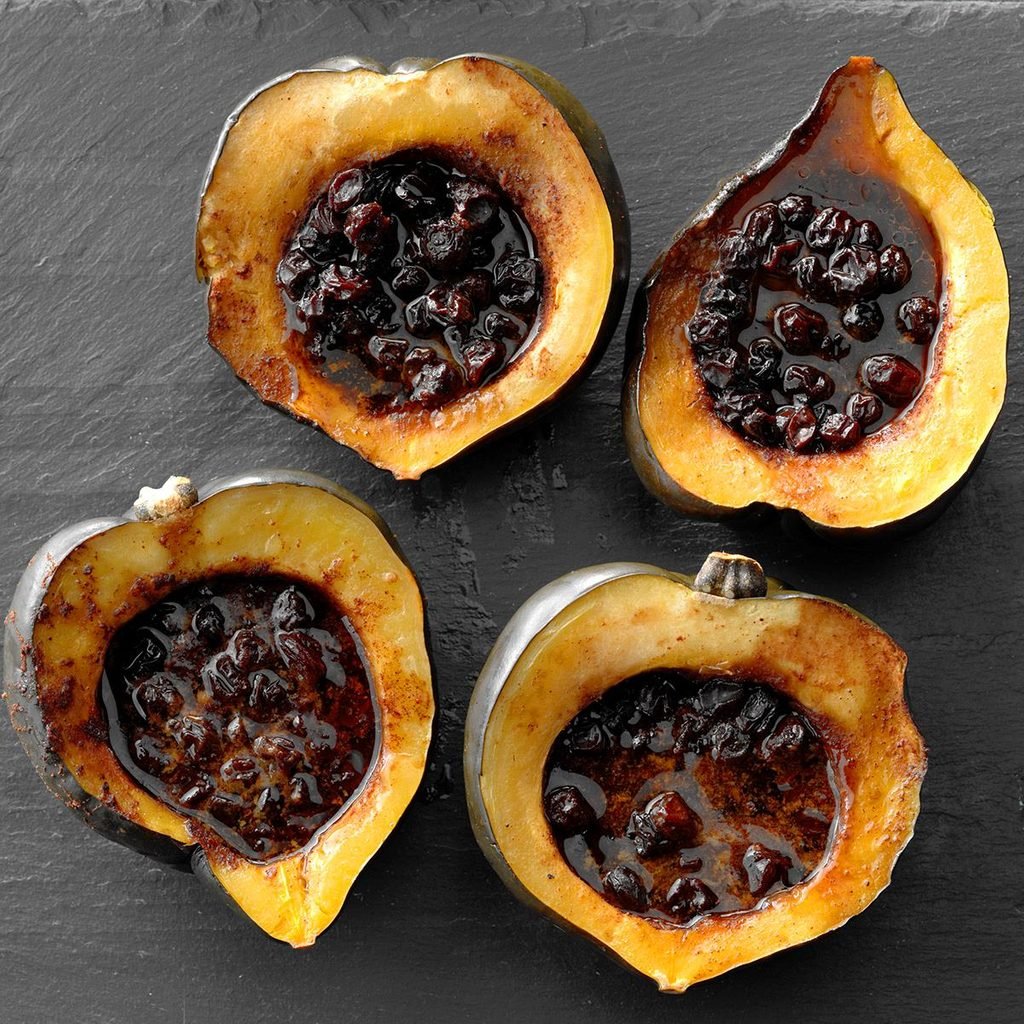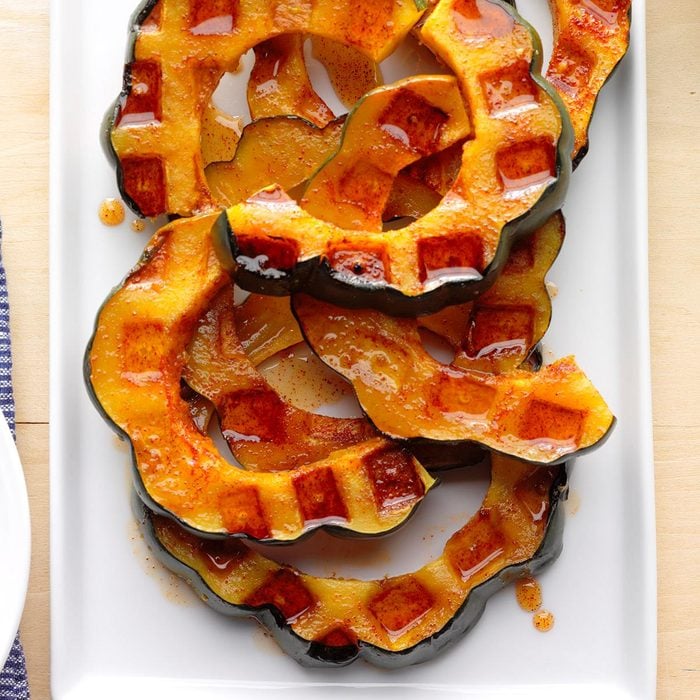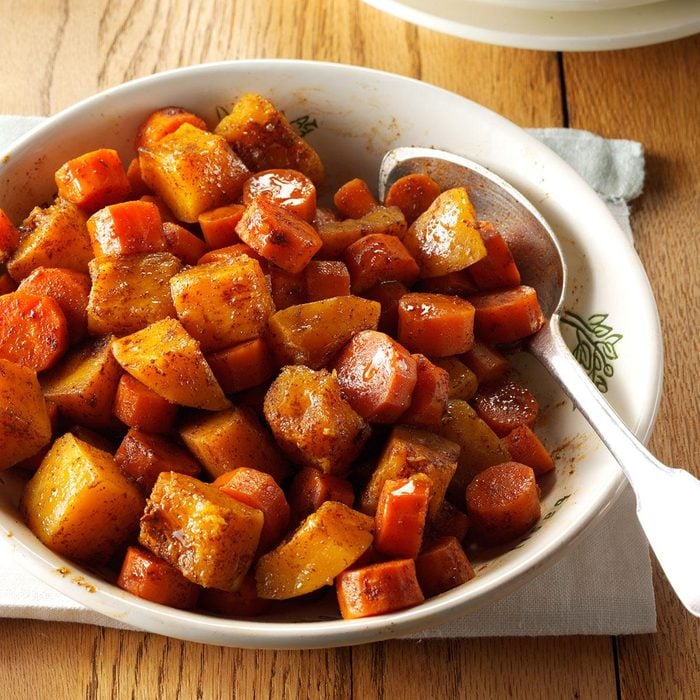Easy Butternut Squash SoupWhen the weather turns cold, get cozy with a bowl of this butternut squash soup. The cream adds richness, but if you're looking to cut calories, it can be omitted. —Taste of Home Test Kitchen
By the way, these are the
types of winter squash you need to know.
Turkey-Stuffed Acorn SquashWe stuff acorn squash with leftovers like turkey, dressing and cranberry sauce. Make as much or as little as you need to use everything up. —Cindy Romberg, Mississauga, Ontario
Spaghetti Squash Meatball CasseroleOne of our favorite comfort-food dinners is spaghetti and meatballs. We're crazy about this lighter, healthier version that features so many veggies. It has the same beloved flavors with more nutritious ingredients! —Courtney Stultz, Weir, Kansas
Ready to get cooking? Here's
how to cut squash.
Hasselback Butternut SquashSquash makes the perfect holiday side dish, especially when it's Hasselback butternut squash! The thin slits cut into each half allow the butter, maple syrup, brown sugar and ground chipotle mixture to get in every single nook and cranny. This is one side that everyone at your holiday table will be excited to gobble up! —Colleen Delawder, Herndon, Virginia
Curry Pomegranate Protein BowlThis recipe is simple and beautiful. It uses a lot of unique flavors that, when blended together, create an out-of-this-world taste sensation. You can substitute other roasted, salted nuts for the soy nuts and can use warmed berry jam in place of the molasses. —Mary Baker, Wauwatosa, Wisconsin
Mushroom & Bacon Spaghetti Squash BowlThis spaghetti squash bowl has a light cream sauce, along with fresh sage and crispy bacon. I love spaghetti squash but get tired of having it with a tomato-based red sauce. This recipe will make you and your family excited about spaghetti squash again! — Emily Montgomery, Madison, Alabama
Chicken with Curry Roasted SquashThis chicken butternut squash curry is very flavorful and full of protein, fiber and phytonutrients. The addition of the apricots adds a mild sweetness to the dish. —Sharon Collison, Newark, Delaware
Roasted Pumpkin Salad with Orange DressingRoasted pumpkin and dried fruits make this beautiful seasonal salad a natural match for holiday recipes. The dressing is a light, tasty mix of honey, olive oil and balsamic vinegar. Top it all off with crumbled goat cheese for that final tangy touch. —Sasha King, Westlake Village, California
Apricot Crab Stuffed Acorn SquashThis light squash recipe is quick, simple and bursting with rich flavors. It looks so elegant when served on a lovely platter. —Judy Armstrong, Prairieville, Louisiana
Pumpkin and Chicken Sausage HashThis can be served as a side or as the main dish for breakfast, lunch or dinner. I like to serve it topped with poached or fried eggs for breakfast. —Valerie Donn, Williamsburg, Michigan
Spaghetti Squash with Apples, Bacon, and WalnutsI've always loved spaghetti squash as an alternative to pasta and enjoy it in the classic marinara style, but I wanted a new recipe so my family and I could enjoy it more often. The savory, salty and sour flavors combine perfectly with a hint of sweet spice. While the squash is baking, prep the rest: It will take only minutes to finish after you shred the squash. —Jeff Tori, Johnstown, Colorado
Sausage and Squash PenneI love using frozen cooked winter squash because the hard work—peeling, chopping and cooking—is all done for me. — Jennifer Roberts, South Burlington, Vermont
Drizzled Butternut BreadMy two young children love this buttercup yellow bread. Squash makes it moist and goes so well with the cinnamon. This will be a welcome addition to a brunch or dinner table.—Misty Thompson, Gaylesville, Alabama
Ravioli with Creamy Squash SauceStore-bought ravioli speeds assembly of this cozy, restaurant-quality dish that tastes so good your family won't notice it's meatless. —Taste of Home Test Kitchen
Pumpkin Clam ChowderWhen autumn arrives, I'm eager to celebrate with warm and cozy comfort food like this pumpkin clam chowder. Use fresh clams if they are available. —Renee Murby, Johnston, Rhode Island
Chicken Parmesan With Spaghetti SquashI grow spaghetti squash and herbs in my garden every year, so this recipe is the perfect way to use them up. —Kristina Krummel, Elkins, Arkansas
Butternut Squash Mac and CheeseI created this dish after my father had triple bypass surgery. He loves comfort food, and I wanted him to be able to enjoy a rich and tasty dish like mac & cheese without all the fat and butter. It's also a smart way to sneak in some veggies for children. —Megan Schwartz, New York, New York
Fig-Carrot Stuffed Kabocha SquashWhile searching for a new winter squash variety, I stumbled upon kabocha squash—it really wowed me. The flavor and texture are both rich and beautiful, and this recipe, which I improvised, really suits the squash well. —Caitlin Stephens-North, Malden, Massachusetts
Cider Baked SquashI'm a freelance writer who sometimes needs a break from a long session of working on a story. That's when I escape to the kitchen to whip up something that's good to eat, yet easy to prepare. This is one of my favorites!
Acorn Squash with Leftover StuffingOur Test Kitchen offer up this unique way to present leftover stuffing. Serve this squash as a hearty side dish or as a meatless entree.
Butternut Squash CustardMy husband first tasted this comforting casserole more than 10 years ago when he was still my fiance. Having enjoyed it so much, he said I needed to offer it at every Thanksgiving dinner. I was happy to oblige!—Maura Calusdian, Londonderry, New Hampshire
Baked Acorn Squash with Blueberry-Walnut FillingI absolutely love squash—and I've filled it with so many variations of savory stuffing over the years. But my favorite way to stuff it is with an unexpected fruit filling, like this sweet apple-blueberry one. —Bruce Newcomer, Fredericksburg, Virginia
Inside-Out Stuffed CabbagePreparing stuffed cabbage rolls can be time-consuming, but this version with butternut squash has the classic flavors —and it’s table ready in just 30 minutes. —Taste of Home Test Kitchen
Cheddar-Butternut Squash ClafoutisI came up with this savory version of the classic French dessert clafoutis and shared it for dinner with a salad. My friends loved it, but in the end I could have eaten the whole pan myself while dreaming of being in Paris with every scrumptious bite. —Joseph A. Sciascia, San Mateo, California
Herbed Butternut SquashThis is just one of many ways I prepare butternut squash for my two girls. It’s a winter staple in our house. —Jenn Tidwell, Fair Oaks, California
Turkey Sausage-Stuffed Acorn SquashFinding healthy recipes the family will eat is a challenge. This elegant squash is one we love, and it works with pork or chicken sausage, too. —Melissa Pelkey Hass, Waleska, Georgia
Sausage & Rice Stuffed PumpkinsMy children often request this dish. It also adds a great "wow" factor to a festive buffet table.—Andria Peckham, Lowell, Michigan
Couscous & Sausage-Stuffed Acorn SquashIf you have a tiny apartment, zero counter space and only two people to feed, hefty meals are out. This acorn squash with couscous is just the right size. —Jessica Levinson, Nyack, New York
Wild Rice Stuffed SquashI made this recipe when we invited both our families to celebrate our first Thanksgiving in our new home. There were 37 of us, and those who tried this dish raved about it. —Robin Thompson, Roseville, California
Squash Custard PieAcorn squash has been a favorite of mine since I was little and my mother baked it with sugar and cinnamon. This particular pie was something I improvised. We love pumpkin pie, but had fresh squash in excess. So I came up with this new variation! It's good to take to potlucks, to pie or cake walks at school, or to serve as a different dessert for Thanksgiving or Christmas. —Mary Kelly, Hopland, California
Baked Butternut SquashTake advantage of fabulous fall produce and roast this scrumptious side. Lightly seasoned with cinnamon, nutmeg and brown sugar, this is my favorite baked butternut squash recipe—it could almost be dessert! —Heidi Vawdrey, Riverton, Utah
Roasted Squash, Carrots & WalnutsAfter the turkey’s done, I dial up the oven temp and roast carrots and squash for this yummy side. That frees me up to start the gravy. —Lily Julow, Lawrenceville, Georgia
Honey-Squash Dinner RollsPuffy dinner rolls take on rich color when you add squash to the dough. Any squash variety works—I've even used cooked carrots. —Marcia Whitney, Gainesville, Florida
Spaghetti Squash & Sausage Easy MealMy son’s favorite dish uses homegrown spaghetti squash, kielbasa, and pico de gallo or salsa. —Pam Mascarenas, Taylorsville, Utah
Easy Grilled SquashThis is grilled butternut squash recipe is one of my favorite ways to cook with fresh produce. I usually make it when I am grilling steak or chicken. —Esther Horst, Monterey, Tennessee
Butternut Squash Oven RisottoSquash and beer make my risotto different and delicious. Plus, cooking it in the oven cuts down on hands-on time making it. Win-win. —Katie Ferrier Gage, Houston, TX
Roasted Pumpkin NachosI had previously made this dish with black beans and corn off the cob in the summer. Wanting to try it with fresh fall ingredients, I replaced the corn with roasted pumpkin—yum! It's also good with butternut squash. —Lesle Harwood, Douglassville, Pennsylvania
Roasted Butternut Squash TacosSpicy butternut squash makes such a great base for these vegetarian tacos. I’m always looking for quick and nutritious weeknight dinners for my family. These fit the bill and are so delicious! —Elisabeth Larsen, Pleasant Grove, Utah
Maple-Glazed Acorn SquashWith a maple syrup and brown sugar glaze, this squash becomes pleasantly sweet. This is comfort food—easy to prepare and a tasty pairing with a pork entree. —Nancy Mueller, Menomonee Falls, Wisconsin
Quinoa-Stuffed Squash BoatsMy colorful “boats” with quinoa, garbanzo beans and pumpkin seeds use delicata squash, a winter squash with edible skin that’s cream-colored with green stripes. In a pinch, acorn squash will do—but don't eat the skin! —Lauren Knoelke, Milwaukee, Wisconsin
Pork Chops & Acorn SquashMy husband and I are crazy for the squash we grow in our garden. For a sweet and tangy dish, we slow-cook it with pork chops and orange juice. —Mary Johnson, Coloma, Wisconsin
Roasted Pumpkin and Brussels SproutsWhile traveling to Taiwan, I had the pleasure of trying a unique vegetable dish that included fresh pumpkin. It inspired me to roast pumpkin with Brussels sprouts. —Pam Correll, Brockport, Pennsylvania
Garlic Spaghetti Squash with Meat Sauce and TomatoI have reduced grains and other starches in my diet due to health reasons, so I was looking for filling, comforting meals without pasta or potatoes. When I was tinkering with this spaghetti squash recipe, I discovered something fun to eat! —Becky Ruff, Mc Gregor, Iowa
Maple-Roasted Chicken & Acorn SquashWhen I became a new mother, my mom helped me find comforting and simple recipes to have on hand. This terrific roast chicken is a happy discovery. —Sara Eilers, Surprise, Arizona
Butternut Squash with Maple SyrupI love this roasted butternut squash because it’s marvelous served hot or cold and it's loaded with flavor from garlic, ginger and leeks. —Marie Willette, Bellows Falls, Vermont
Arizona Chicken in Acorn SquashGive stuffed acorn squash a taste of the Southwest with this comforting recipe. We love the crunch of the toasted almonds, heat of green chiles, and creamy texture of avocado. —Martha Sparlin, Albuquerque, New Mexico
Roasted Acorn Squash & Brussels SproutsI love creating dishes with few ingredients and easy steps, like squash with Brussels sprouts. Maple syrup adds a slight sweetness, and pecans give it a toasty crunch. —Angela LeMoine, Howell, New Jersey
Cranberry Roasted SquashI created this recipe one day when I wanted a warm, fragrant side dish. The aroma of the cranberries and squash cooking in the oven is just as heavenly as the flavor itself. —Jamillah Almutawakil, Superior, Colorado
Maple Winter Squash CasseroleThis scrumptious casserole combines pumpkin and two other kinds of squash
in a creamy, savory mix. The recipe also would work with other squash combos,
or just one type instead of three. Have fun with it—you really can't go wrong! —Joanne Iovino, Kings Park, New York
Maple-Glazed SquashSquash gets pleasantly sweet and spicy flavors from maple syrup and cinnamon in this recipe. —Betty Kay Sitzman, Wray, Colorado
Roasted Butternut Squash BreadButternut squash is so versatile, I use it to make a sweet and savory bread that’s fabulous for breakfast, snacking or even dessert. —Sarah Meuser, New Milford, Connecticut
Roasted Herbed Squash with Goat CheeseCooking is a hobby I'm so happy to share with my toddler. She (and all our Christmas Eve party guests) heartily approved of this new potluck favorite. Any type of winter squash works here. —Lindsay Oberhausen, Lexington, Kentucky
Quick Ham and Bean SoupIf you like ham and bean soup but don't want to spend hours in the kitchen, this tasty, quick version will leave you with a satisfied smile. —Taste of Home Test Kitchen
Butternut & Portobello LasagnaLasagna gets fresh flavor and color when you make it with roasted butternut squash, portobello mushrooms, basil and spinach. We feast on this. —Edward and Danielle Walker, Traverse City, Michigan
Warm Squash & Quinoa SaladWhenever I see butternut squash at the supermarket, I buy one. It's amazing tossed with earthy quinoa, Italian spices and crunchy pine nuts. And don't get me started on the browned butter! Yum. —Carly Taylor, Libertyville, Illinois
Butternut Squash ButterLooking for a tasty way to use up those pumpkins and have a wonderful gift during the holidays? My pumpkin butter is delicious on biscuits or homemade bread, and also makes a tempting filling for miniature tart shells. —Wanda Richardson, Somers, Montana
Spiced Butternut Squash PieMy mom always made this dessert with her homegrown squash. It was my dad's favorite after-dinner treat. I continue to make it to this day. —Johnna Poulson, Celebration, Florida.
Rustic Squash TartsThis recipe is hiding a big surprise. Flaky, rustic-looking pastry shells hold a sweet and spicy pecan layer under the squash slices. —Ann Marie Moch, Kintyre, ND
Acorn Squash with Cranberry StuffingIf you have squash or cranberry lovers at the table, here’s your new go-to recipe. It’s colorful, the blend of flavors is delicious and it’s a fitting addition to a Thanksgiving menu. —Dorothy Pritchett, Wills Point, Texas
Sausage, Kale and Squash Bread PuddingWho said bread pudding has to be for dessert? I love to serve this for brunch or dinner when I want something hearty and a little unusual. —Lauren Knoelke, Milwaukee, Wisconsin
Winter Vegetable Shepherd's PieEveryone eats for comfort during the holidays, but comfort foods aren't necessarily healthy. To make a classic comfort food dish healthier, I came up with this lovely take: butternut squash shepherd's pie with ground turkey. It's perfect for putting out on your holiday buffet table. —Ann Sheehy, Lawrence, Massachusetts
Wild Rice and Squash PilafThis pilaf is fantastic with fish or poultry and especially compatible with turkey. Since it's so colorful, I like to think it makes my turkey dressed for the holidays. —Erica Ollmann, San Diego, California
Butternut Squash RollsWith their cheery yellow color and delicious aroma, these appealing buns will brighten your buffet table. Plus, I've found this recipe is a wonderful way to use up squash from the garden. —Bernice Morris, Marshfield, Missouri
Winter Squash CasseroleYears ago, our vegetable garden kept us well-supplied all year long. Dad stored huge piles of potatoes and squash in the coldest part of the basement. In winter the squash was so hard. Mother sometimes used an ax to cut it into small pieces for cooking! Her hard work was worth it, because we really enjoyed this wonderful casserole! —Glendora Hauger, Siren, Wisconsin
Apple Squash SoupI add a little ginger and sage to this creamy butternut squash apple soup. My family loves it when autumn rolls around. —Crystal Ralph-Haughn, Bartlesville, Oklahoma
Squash & Chicken StewWe created a satisfying stew that’s nutritious, loaded with flavor and family-friendly. Slowly simmer chicken thighs with stewed tomatoes, butternut squash, green peppers and onion for meal-in-one convenience. —Taste of Home Test Kitchen
Butternut Squash Apple BakeEven those who aren't fans of squash enjoy this side dish. Sweet slices of butternut squash are topped with apples covered in a cinnamon-sugar glaze for a quick and easy dinner accompaniment. —Ellie Klopping, Toledo, Ohio
Chipotle Butternut Squash SoupMy hearty soup uses herbs and vegetables from the garden along with convenient pantry items, so it’s easy, fast and mostly fresh. Your family will devour it. —Roxanne Chan, Albany, California
Vegetable Lentil SoupHere’s a healthy
slow-cooker soup that's ideal for vegetarians and those watching their weight. Butternut squash and lentils make it hearty, while herbs and other veggies round out the flavor. —Mark Morgan, Waterford, Wisconsin
Persimmon Squash PieI created this recipe for our local persimmon festival, using homegrown squash. I like to make two pies, with toffee bits and pecans for garnish. —Betty Milligan, Bedford, Indiana
Pasta with Creamy Fennel SauceWhen pureeing fennel one day, I realized its velvety texture would make for a creamy, delicious pasta sauce—without all the guilt. My experiment worked, and now I enjoy this good-for-you pasta sauce all the time. —Deb Schwab, Moraga, California
Butternut Squash and Barley SoupI love to use my garden produce in this veggie-packed soup. Serve it with bread or oatmeal dinner rolls and you have a delicious, healthy dinner. —Julie Sloan, Osceola, Indiana
Spicy Pork and Butternut Squash RaguThis recipe is a marvelously spicy combo that's perfect for cooler fall weather and satisfying after a day spent outdoors. —Monica Osterhaus, Paducah, Kentucky
Butternut Squash and Carrot SoupI got this golden soup recipe from a friend. Sometimes I add a few slices of red pepper to change up the flavor a bit. —Pat Roberts, Thornton, Ontario
Butternut Squash Dinner RollsThese wholesome rolls are a pleasant addition to any entree. I get so many requests for them at holiday time. I make about 100 dozen in December! —Ula Kessler, Liberty Center, Ohio
Tropical Squash and Black Bean BurritosThe pineapple salsa in these hearty burritos gives you a taste of the tropics on a chilly day. Stuffed with black beans, butternut squash and spinach, they're a nutritious, delicious and fun dinner for any night. —Deanna McDonald, Grand Rapids, Michigan
Butternut Squash ChiliAdd butternut squash to chili for a tasty, filling, energy-packed dish your whole family will love. Mine does! —Jeanne Larson, Mission Viejo, California
Butternut Squash and Sausage Stuffed ShellsI rarely invite friends for dinner without someone requesting this easy pasta casserole. The sweet squash complements the spicy sausage, and the creamy goat cheese makes it all just melt in your mouth! You can substitute manicotti or even rolled lasagna noodles for the shells. The stuffed shells and sauce can be prepared a day ahead and assembled just before baking. —Taylor Hale, Sonoma, California
Golden Butternut Squash LasagnaMy rich, saucy lasagna features winter squash at its finest. The whipped cream topping adds a unique twist to this meatless casserole packed with roasted butternut squash, two kinds of cheese and a host of seasonings. Allowing the lasagna to stand for 10 to 15 minutes before serving makes it easier to cut. —Lisa Sheets, Carmel, Indiana
Skillet Shepherd's PieThis is the best shepherd's pie recipe I've ever tasted. It's very quick to make, and I usually have most—if not all—of the ingredients already on hand. —Tirzah Sandt, San Diego, California
Butternut GoulashWe make this treasured family goulash recipe using squash from our own backyard. The chili powder and cayenne really warm you up! —Allison Wilmarth, Forest City, Pennsylvania
Hubbard Squash PieMy mom made this pie—never pumpkin—each Thanksgiving, and everyone looked forward to it. I have fond memories of my dad cutting up a hulking big blue Hubbard squash on the kitchen counter and cooking it in order for Mom to make the pies. A more manageable butternut squash will deliver an equally delicate-tasting pie! —Patti Ann Christian, Ararat, North Carolina
Hearty Butternut Squash SoupThe comforting combination of squash, meat, beans and veggies makes this my go-to soup in fall. It's full of freshness. —Jaye Beeler, Grand Rapids, Michigan
Sausage-Stuffed Butternut SquashLoad butternut squash shells with an Italian turkey sausage and squash mixture for a quick and easy meal. Even better, it's surprisingly low in calories. —Katia Slinger, Columbus, Georgia
Festive Fall Tortellini TossFall is my favorite season and I love the foods of autumn, such as mushrooms, squash, apples and walnuts. I combined these all with pasta to make a delicious side dish perfect for sharing at a potluck; the recipe can easily be doubled and can be served either warm or at room temperature. —Roxanne Chan, Albany, California
Roasted Butternut Tossed SaladThis salad makes an easy and special side dish for Thanksgiving dinner, and it's packed with nutritious veggies, almonds, berries and squash. —Katie Wollgast, Florissant, Missouri
Cheesy Bacon Spaghetti SquashThis quick casserole is called "cheesy" for a reason. Stir in any kind you've got. —Jean Williams, Stillwater, Oklahoma
Spaghetti Squash Lo MeinMy colorful Lo Mein is a lighter version of the classic Chinese dish that everyone at our table loves. Try it with a squirt of Sriracha. —Loanne Chiu, Fort Worth, Texas
Spiced Acorn SquashWorking full time, I found I didn't always have time to cook the meals my family loved, so I re-created many of those dishes in the slow cooker. This treatment for squash is one of our favorites. —Carol Greco, Centereach, New York
Waffle-Iron Acorn SquashI love to get the kids involved in cooking, and this squash is so simple even a small child can cook it with minimal adult supervision. The recipe is fun, fast and no-fuss, and doesn't use valuable oven space before big family meals. —Donna Kelly, Orem, Utah
Ginger Butternut Squash BisqueThis soup is filling enough for my husband, and it’s vegetarian, which I love. The couple who introduced us made it for us on a freezing night and we’ve been hooked ever since. —Cara McDonald, Winter Park, Colorado
Italian Spaghetti SquashThis is a unique and easy way to cook spaghetti squash. Be sure the squash is on the small or medium side so that it fits into the slow cooker after being cut in half. —Melissa Brooks, Sparta, Wisconsin
Spaghetti Squash Casserole BakeOne of our daughters shared this recipe along with squash from her first garden.—Glenafa Vrchota, Mason City, Iowa
Spiced Carrots & Butternut SquashWhen I've got a lot going on, my slow cooker is my go-to tool for cooking veggies. The sweetness of the squash and carrots really complements the spicy seasonings. —Courtney Stultz, Weir, Kansas
